Physical Address
304 North Cardinal St.
Dorchester Center, MA 02124
Acknowledgments: I would like to acknowledge the recent work of Dr. Charles Day and the numerous previous editions by Dr. Peter Stern. Their brilliantly written chapters on this topic have been combined, modified, and updated to create this work.
Fractures of the metacarpals and phalanges are the most common fractures of the upper extremity. , In a series of 11,000 fractures, Emmett and Breck noted that these fractures accounted for 10% of the total. Hove, in a consecutive series of 1000 carpal, metacarpal, and phalangeal fractures, found that 82% involved the metacarpals or phalanges. The outer rays of the hand (thumb and small finger) are the most frequently injured digits; however, the most commonly fractured bone in the hand is the distal phalanx of the long finger. Unfortunately, metacarpal and phalangeal fractures are often neglected or regarded as trivial injuries. Swanson aptly stated: “Hand fractures can be complicated by deformity from no treatment, stiffness from overtreatment, and both deformity and stiffness from poor treatment.”
The incidence of metacarpal and phalangeal fractures peaks between 10 and 40 years and is most common in males, , a time when athletic and industrial exposure is the greatest. Sporting injuries alone accounted for nearly one-quarter of metacarpal and phalangeal fractures in a recent prospective population database from the United Kingdom. , Chung and Spilson, using data from the National Hospital Ambulatory Care Survey, estimated that in 1998 there were approximately 1.5 million hand and forearm fractures in the United States. More than 600,000 of these were metacarpal and phalangeal fractures. Using 2010 U.S. census data, Karl et al. noted an incidence of phalangeal and metacarpal fractures to be 12.5 and 8.4 per 10,000 persons, respectfully. While distal radius fractures were more common overall with a bimodal age distribution, metacarpal and phalangeal fractures were the most common upper extremity fractures in patients 18 to 49 years of age.
Until the early part of the 20th century, these fractures were all managed nonoperatively. In fact, the entire history of operative fixation for hand fractures is limited to the last 100 years and was pioneered by Albine Lambotte. Despite significant advancements in surgical techniques and implants, even today, the vast majority of these fractures can be successfully managed by nonoperative techniques.
Most fractures are functionally stable either before or after closed reduction and will fare well with protective splintage and early mobilization. Certain fractures require operative fixation ( Box 7.1 ). Selection of the optimum treatment depends on a number of factors, both fracture-specific and patient-specific. Fracture-specific factors include fracture location (intraarticular versus extraarticular), fracture geometry (transverse, spiral or oblique, comminuted), deformity (angular, rotational, shortening), the presence of open wounds, associated osseous and soft tissue injuries, and fracture stability. Additional patient-specific considerations include age, occupation, handedness, and socioeconomic status; the presence of systemic illnesses; compliance; and ability to tolerate the requisite period of immobilization for nonoperative care.
Irreducible fractures
Malrotation (spiral and short oblique)
Articular fractures
Subcapital fractures (phalangeal)
Open fractures
Segmental bone loss
Polytrauma with hand fractures
Multiple hand or wrist fractures
Fractures with soft tissue injury (vessel, tendon, nerve, skin)
Reconstruction (i.e., osteotomy)
Numerous treatment options exist, including immobilization with casts or splints, percutaneous techniques, and open reduction with internal or external fixation. Each of these modalities is acceptable, and treatment must be individualized based on fracture-specific and patient-specific consideration. Regardless of the treatment selected, the goal is maximal restoration of hand function in a timely fashion with minimal morbidity. Over the last several decades, operative fixation of hand fractures has gained increasing popularity. Current operative trends include minimally invasive techniques such as intramedullary screws, immediate postoperative motion protocols, and wide awake surgery local anesthesia no tourniquet (WALANT).
Although prolonged immobilization is to be avoided because of the risk of permanent deformity and stiffness, one should remember that overly aggressive attempts at internal fixation may lead to soft tissue damage, tendon adhesion, infection, and the necessity for a secondary procedure for implant removal. Operative fixation must be used judiciously and with the expectation that the ultimate outcome will be as good as or better than the anticipated outcome of nonoperative management.
Fractures of the metacarpal head are rare and are usually articular. In a series of 134 closed articular fractures of the metacarpophalangeal (MCP) and proximal interphalangeal (PIP) joints, Hastings and Carroll noted five metacarpal head fractures. These fractures are usually the result of axial loading or direct trauma (crush or clenched-fist injury). Any open fracture of the metacarpal head should carry a high index of suspicion for a clenched fist injury or “fight bite.”
McElfresh and Dobyns reported on 103 intraarticular metacarpal head fractures. The injury involved the index metacarpal most frequently, presumably because it is a border digit and its metacarpal base is fixed to the carpus. The fractures were classified into several categories ( Box 7.2 ). Comminuted fractures were most common. Half the patients with comminuted fractures had loss of more than 45 degrees of flexion at the MCP joint. Articular defects may remodel with time, and unlike weightbearing joints, an incongruous MCP joint may function satisfactorily with painless motion.
Epiphyseal (all nondisplaced Salter-Harris type III)
Ligamentous avulsions
Osteochondral shear fractures
Two-part fractures occurring in different planes (sagittal, coronal, axial)
Comminuted fractures
Boxer fractures with articular extension
Fractures with substance loss
Occult compression fractures with subsequent avascular necrosis
Articular fractures of the metacarpal head can also occur following complex dorsal MCP dislocations. Becton et al. noted such a fracture in 7 of 13 patients and recommended open reduction and internal fixation (ORIF) through a dorsal approach. Additionally, the presence of a metacarpal head fracture can render MCP joint dislocations irreducible, thus necessitating ORIF through either volar, dorsal, or combined approaches.
X-ray evaluation requires a minimum of three views: posteroanterior, lateral, and oblique. The lateral view is difficult to interpret because of the adjacent overlying metacarpal heads. The Brewerton view (MCP joint flexed 65 degrees with the dorsum of the fingers lying flat on the x-ray plate and the tube angled 15 degrees in an ulnar-to-radial direction) can be helpful to delineate collateral ligament avulsion fractures of the metacarpal head not seen on routine views. A skyline metacarpal view may also be helpful in visualizing the dorsal articular profile of the metacarpal head following a clenched-fist injury. The MCP and interphalangeal (IP) joints are fully flexed and the beam is directed parallel to the dorsal shaft of the proximal phalanx. If fracture visualization remains suboptimal on radiographs or operative intervention is contemplated, then computed tomography (CT) is often necessary.
Treatment of these fractures must be individualized. Displaced ligament avulsion fractures and osteochondral fractures can be satisfactorily managed by ORIF. Kumar and Satku emphasized that small osteochondral fragments should not be discarded but instead “trapped in place” by larger fragments and not separately internally fixed. Two-part coronal, sagittal, and oblique articular fractures are best managed by ORIF with Kirschner wires, small headless compression screws, or interfragmentary screws , , ( Fig. 7.1 ). A recent study of 13 patients managed with open reduction and headless compression screws, Kirschner wires, or both achieved union in all cases, 89 degrees MCP range of motion and Disabilities of the Arm, Shoulder, and Hand (DASH) 3.8 at 1-year follow-up, highlighting the need for accurate reduction and stable fixation in these injuries. With refinements in small joint arthroscopy, the role of arthroscopic-assisted reduction with pinning or internal fixation of these injuries has been expanding in recent years though few studies have been published. (See Chapter 17 .)
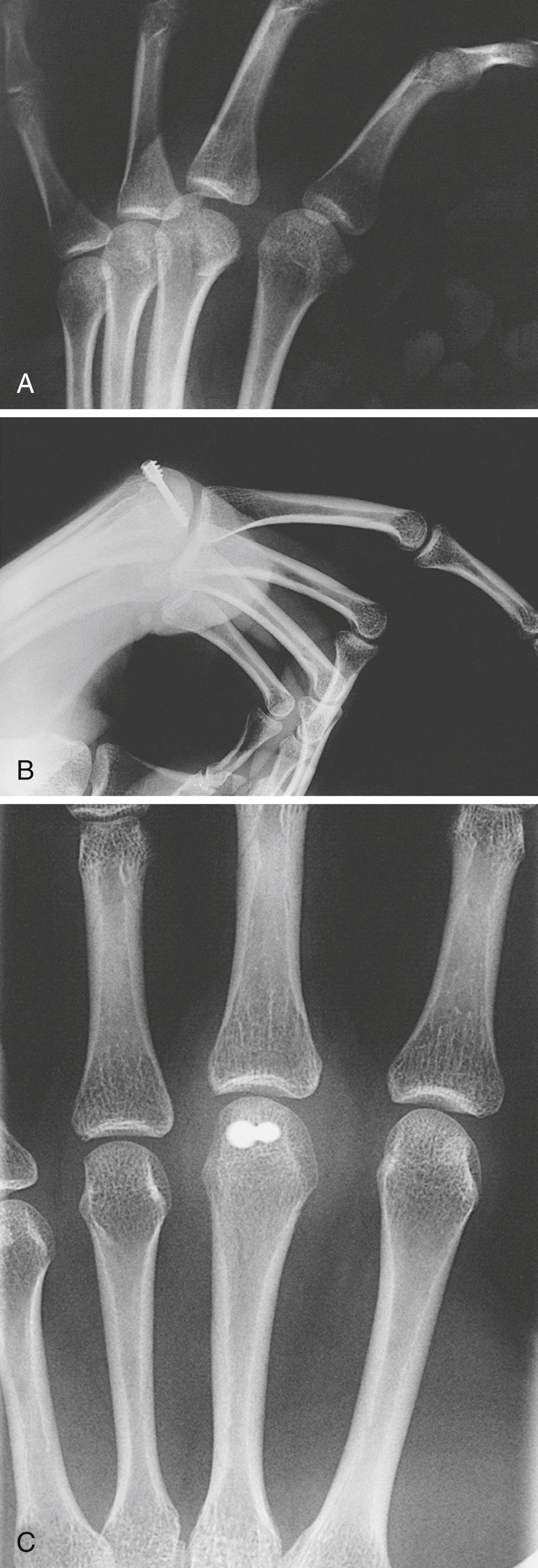
Occasionally, an injury occurs with partial loss of a metacarpal head. While smaller defects may be tolerated, large defects have been successfully managed with osteochondral grafting. Boulas , has reported successful short-term results with osteochondral autografts taken from a corresponding toe, and Capo and Orillaza reported utilizing a nonarticulating portion of the dorsal aspect of the same metacarpal head successfully. More commonly however, osteochondral autografts are obtained from the knee and press-fit into the corresponding defect in the metacarpal head. This can be done acutely for focal defects or as a salvage for posttraumatic osteonecrosis.
A comminuted articular fracture is the most difficult to treat. It is often associated with soft tissue injuries and metaphyseal compaction or bone loss. Open reduction and internal fixation may be challenging, if not impossible. Alternative forms of treatment include skeletal traction, volar plate interposition arthroplasty, or silicone arthroplasty , ( Fig. 7.2 ). In a series of 14 patients, Nagle et al. recommended immediate silicone arthroplasty for open nonsalvageable articular fractures of the PIP and MCP joints. With slightly over 2 years of follow-up, active range of motion at the MCP joint averaged 60 degrees. There were no deep infections or implant failures, but malrotation was occasionally a problem.
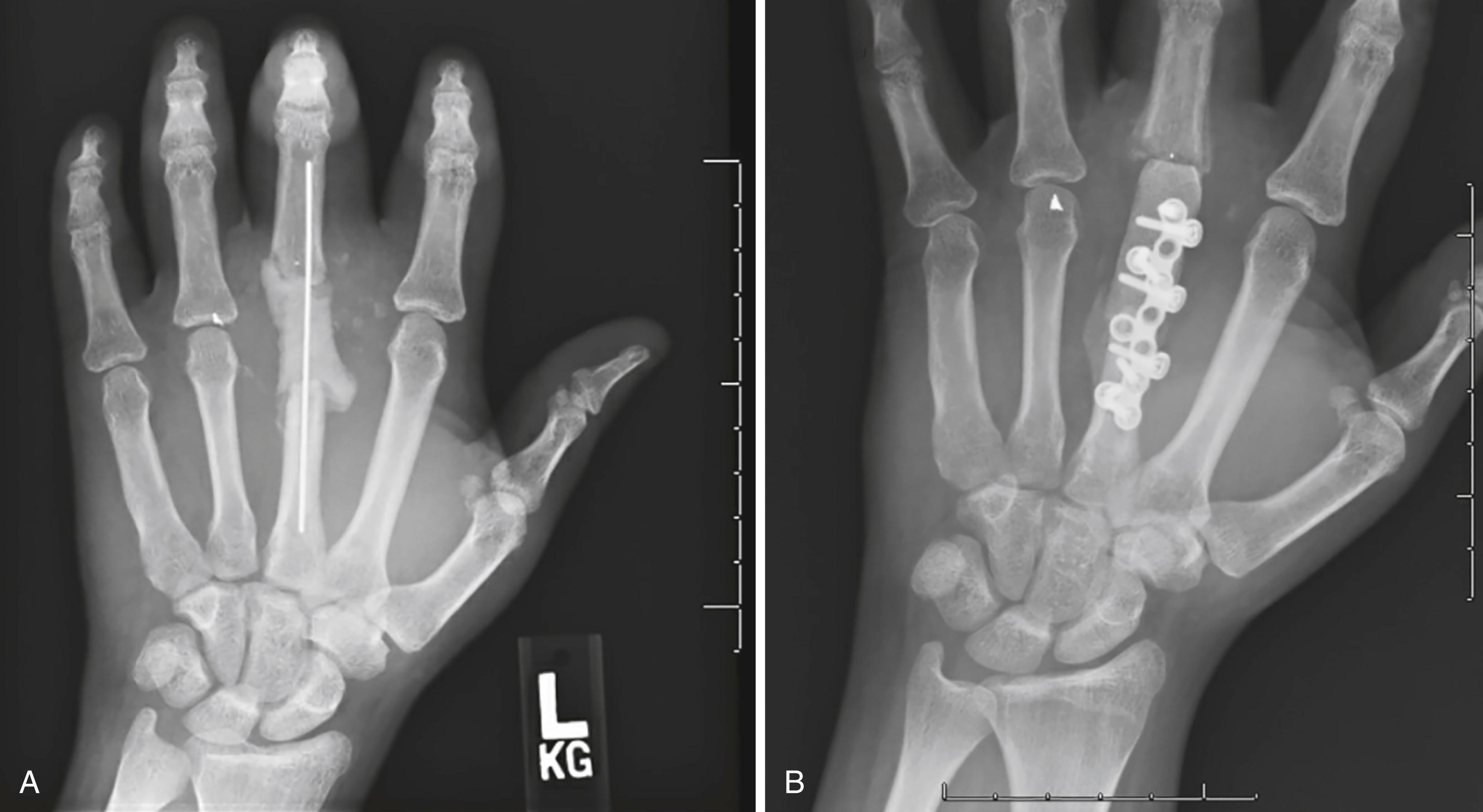
The most common complication of articular fractures of the metacarpal head is stiffness. This may result from extensor tendon adhesions, collateral ligament or dorsal capsular contracture, or articular incongruity. Dibbell and Field reported recurrent locking of the MCP joint secondary to a malunited, impacted metacarpal head fracture. While technically challenging, successful articular malunions can be managed with osteotomy and rigid internal fixation.
Epiphyseal arrest can follow children’s metacarpal head fractures. To minimize longitudinal growth arrest, Light and Ogden recommended open reduction and internal fixation of displaced articular metacarpal head fractures. Avascular necrosis , , can also occur, is found predominantly in young adults, and usually involves the index and middle fingers. Büchler and Fischer reported avascular necrosis in 3 of 17 cases when the minicondylar plate was used for metacarpal neck fixation. Whether this was the result of the injury or the fixation was not clear.
Noncomminuted fractures with more than 25% of the articular surface involved or greater than 1-mm of articular step-off should be treated operatively. I approach the majority of these fractures through a dorsal longitudinal incision that splits the extensor tendon to expose the joint. Shear fractures involving the volar portion of the joint are better served with a volar approach through the A1 pulley to allow access to the volar 50% of the metacarpal head. Two-part articular fractures are usually amenable to fixation with headless compression screws. In performing the reduction, care must be taken to preserve soft tissue attachments to the articular fragment(s) to avoid devascularization. Fixation with Kirschner wires, although easier, is not as desirable because fixation is less rigid and may delay mobilization of the joint; however, for fragments too small for screw fixation I will often use threaded Kirschner wires cut flush to augment fracture stability.
Open fractures of a metacarpal head secondary to a clenched fist injury should be treated by formal irrigation and debridement. The wound should be left open and internal fixation, if necessary, delayed until the wound is clean and shows no sign of infection.
Comminuted fractures are problematic. Direct fracture fixation with multiple Kirschner wires or cerclage wire often fails to stabilize the fracture and maintain the reduction. For closed injuries, I prefer immobilization for 2 weeks with the MCP joint flexed 70 degrees, followed by aggressive range-of-motion exercises. Skeletal traction or external fixation may be needed if there are associated comminuted fractures of the adjacent base of the proximal phalanx. For open comminuted head fractures, especially those with bone loss due to gunshot wounds, I have used the volar plate interposition (also known as “Tupper arthroplasty”) when the volar plate was available. For the most severe injuries with bone loss, I have used a temporary cement spacer followed by autogenous bone graft replacement (Masquelet technique) with subsequent MCP fusion or volar plate interposition (see Fig. 7.2 ).
Metacarpophalangeal arthrodesis is a salvage procedure that results in loss of mobility and length if done primarily; it should not be done acutely because of the risk of excessive shortening or nonunion, and the Masquelet technique has been beneficial for me in these most challenging cases.
Metacarpal neck fractures (boxer’s fracture) are common and usually involve the ring and small metacarpals. “Boxer’s fracture” is really a misnomer as these injuries are rarely seen in professional boxers; they are far more common in brawlers and in people who hit solid objects such as walls. They invariably occur when a clenched fist strikes an immobile object and the metacarpal neck fractures with an apex dorsal angulation. Apex dorsal angulation occurs because:
The impact occurs on the dorsum of the metacarpal head and causes comminution of the volar metacarpal neck.
Forces of the intrinsic muscles that cross the MCP joint lie volar to its axis of rotation and create a bending moment on the fracture.
While several treatment options are described ranging from percutaneous fixation to a variety of techniques for open reduction and internal fixation, the overwhelming majority of metacarpal neck fractures can be effectively managed with nonoperative treatment. Nonunion virtually never occurs; however, malunion may be a problem. Patients with a malunion may complain of a loss of the contour of the metacarpal head, diminished range of motion, prominence of the metacarpal head in the palm, and occasionally, rotational malalignment or crossover.
When deciding on treatment, several factors should be taken into consideration as outlined in Box 7.3 .
Open fracture
Rotational malalignment resulting in digital overlap
Significant “pseudoclawing” (MCP hyperextension and PIP flexion from dynamic instability due to shortening) resulting in functional impairment
Involved digit
More ulnar digits are more tolerant of angulation in part due to greater CMC motion
Multiple digits are more difficult to manage closed
Degree of angulation
No prescriptive values though the small finger can often tolerate up to 70 degrees while the radial two digits may have tolerance as low as 10 to 15 degrees.
Amount of bone shortening
In the absence of significant pseudoclawing often well tolerated even up to 1 cm in some reports
Patient factors
Patient vocation/recreational requirements
Some patients necessitate more rapid return to work or activities.
Patient medical and social risk factors for having surgery
Several authors have noted that it is difficult to consistently measure the degree of angulation in boxer’s fractures. Using lateral x-rays, angulation can be measured by either lines that pass through the shaft (medullary canal) of the metacarpal and center of the metacarpal head or by lines that run tangential to the dorsal cortices of the proximal and distal fragments. Lamraski et al. found high interobserver and intraobserver reliability using angular measurements on lateral radiographs but emphasized the importance of true lateral radiographs for accuracy. Measured fracture angulation has been shown to positively influence surgeons’ decisions to operate on small finger metacarpal neck fractures, though this has not been linked to improved functional outcomes.
Substantial recent evidence using validated patient-reported outcome instruments support excellent clinical outcomes with nonoperative treatment of even significantly displaced small finger metacarpal neck fractures. Westbrook et al. found no correlation between the degree of malunion and grip strength or DASH in a series of 105 metacarpal neck fractures. Similarly, in a prospective series of 73 small finger metacarpal neck fractures, Lowdon noted no relationship between the presence of symptoms and residual angulation. Pace et al. demonstrated while closed reduction improves the initial alignment, ultimate alignment of the healed fracture is not affected. The reported excellent clinical results in the face of malunion has led authors to question the need for any immobilization, , , the need for follow-up radiographs, and even the need for follow-up visits.
No one ideal method of protection during healing of small finger metacarpal neck fractures is universally accepted. In terms of casting versus functional bracing, no one method has been shown to be superior in terms of ultimate outcome , ; however, functional bracing led to more rapid return to work and faster clinical improvement. When examining the need for any immobilization, numerous studies have failed to demonstrate the superiority of immobilization. , , Braakman et al. prospectively treated 100 fifth metacarpal neck fractures with either cast immobilization or functional taping of the ring to the small finger. The majority of fractures were not reduced, and at the end of treatment, functional taping was recommended. Pellatt et al. compared 48 patients managed with buddy taping with 49 patients managed with casting and found no difference in quick-DASH scores between the cohorts and fewer days off work in the buddy taping group. In a 2016 systematic review of all studies comparing reduction and immobilization to soft wraps without reduction, immobilization was found to be unnecessary.
Several studies comparing operative and nonoperative treatment of small finger metacarpal neck fractures have failed to demonstrate superiority of operative treatment. In 218 small finger metacarpal neck and shaft fractures, Westbrook et al. found nonoperative treatment superior to pinning and plating in terms of DASH and esthetic outcome with similar results in terms of grip strength and union rate. A metaanalysis of six randomized controlled trials totaling 288 patients by Zong et al. found conservative treatment to be the optimal treatment due to the lowest complication rate compared with pinning, plate fixation, and antegrade intramedullary nailing.
Because of the lack of compensatory carpometacarpal (CMC) motion, there is almost universal agreement that residual angulation over 10 to 15 degrees in fractures of the index and middle metacarpal necks should not be accepted, though to date there is little published evidence given the less common nature of this injury.
Jahss recognized that flexing the MCP joint to 90 degrees relaxed the deforming intrinsic muscles and tightened the collateral ligaments, thereby allowing the proximal phalanx to exert upward pressure on the metacarpal head. He applied a cast in two parts, first immobilizing the proximal metacarpal fragment and then flexing the MCP and PIP joints and pushing upward on the flexed PIP joint while applying the second part. He reported 10 cases with uniformly satisfactory results. This reduction method gained wide popularity, but the casting method has since largely been abandoned because persistent PIP stiffness or skin necrosis developed over the dorsum of the PIP joint in some patients. The “Jahss maneuver” today remains an excellent technique of closed reduction ( Fig. 7.3 ); however, the small finger should never be immobilized in the “Jahss position” with both joints flexed 90 degrees. In fact, the traditional dogma of always immobilizing the MCP joint in flexion has recently been challenged with respect to small finger metacarpal neck fractures. In 81 active-duty military patients, no difference was found with respect to maintaining reduction, range of motion, grip strength, or DASH scores between those managed with the MCP joints flexed or extended in the cast; though the authors noted easier cast application with the MCP joint extended. Similarly, Tavassoli et al. retrospectively found no difference in range of motion, grip strength, or final fracture alignment based on the position of immobilization in 263 patients.
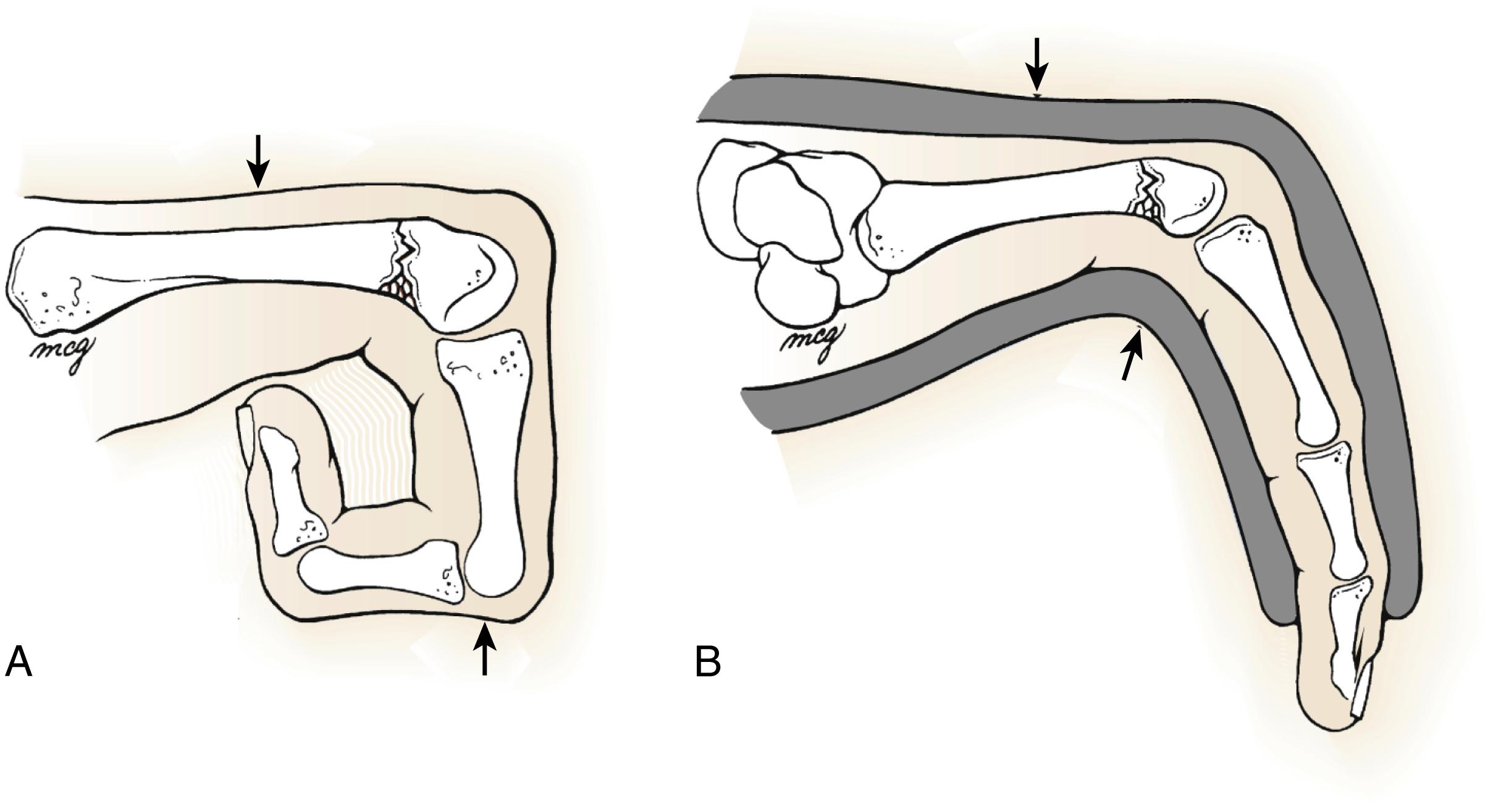
Closed reduction with percutaneous pinning was reported first by Bosworth in 1937 and remains a popular method of treatment for metacarpal neck and shaft fractures. Pinning can be performed in either an antegrade, retrograde, or transverse manner, with a single or multiple pins and with the pins buried or left exposed. Percutaneous pinning has the advantage of being simple, less expensive, and minimally invasive, and should reduce the likelihood of postoperative swelling and stiffness that frequently follows open reduction and internal fixation. The disadvantages are that it does not provide rigid fixation and some form of external immobilization is necessary, and it carries the risk of pin site infection especially when pins are left exposed and the potential need for an additional operation for pin removal if they are buried. In terms of the direction of pin placement, two studies have demonstrated superiority of an antegrade open technique in the short term (less than 3 months) but no benefits of one technique over the other by 6 months. ,
Foucher has reported excellent results with the use of “bouquet” osteosynthesis in the management of displaced small finger metacarpal neck fractures. The fracture is reduced in closed fashion, holes are made in the proximal ulnar metaphysis of the metacarpal, and three blunt prebent Kirschner wires are passed antegrade down the medullary canal, across the fracture, and into the subchondral bone of the metacarpal head ( Fig. 7.4 ). This has the advantage of avoiding the fracture site but can be technically difficult and pins can migrate either proximally or distally. A variation to this technique is the use of a single, larger intramedullary (IM) wire for fixation, which has been shown to be noninferior and less technically demanding. , In a prospective, multicenter randomized study of 85 patients with a minimum of 30 degrees of angulation of small finger metacarpal neck fractures, no difference was found between closed reduction with bouquet pinning and nonoperative treatment without reduction in terms of quick-DASH, pain, range of motion, grip strength, or quality of life at 1 year. In terms of comparing IM pinning versus percutaneous transverse pinning, the literature is conflicting with studies showing no difference in outcome, , faster operative time and lower complications with transverse pinning, and superior outcomes with IM pinning.
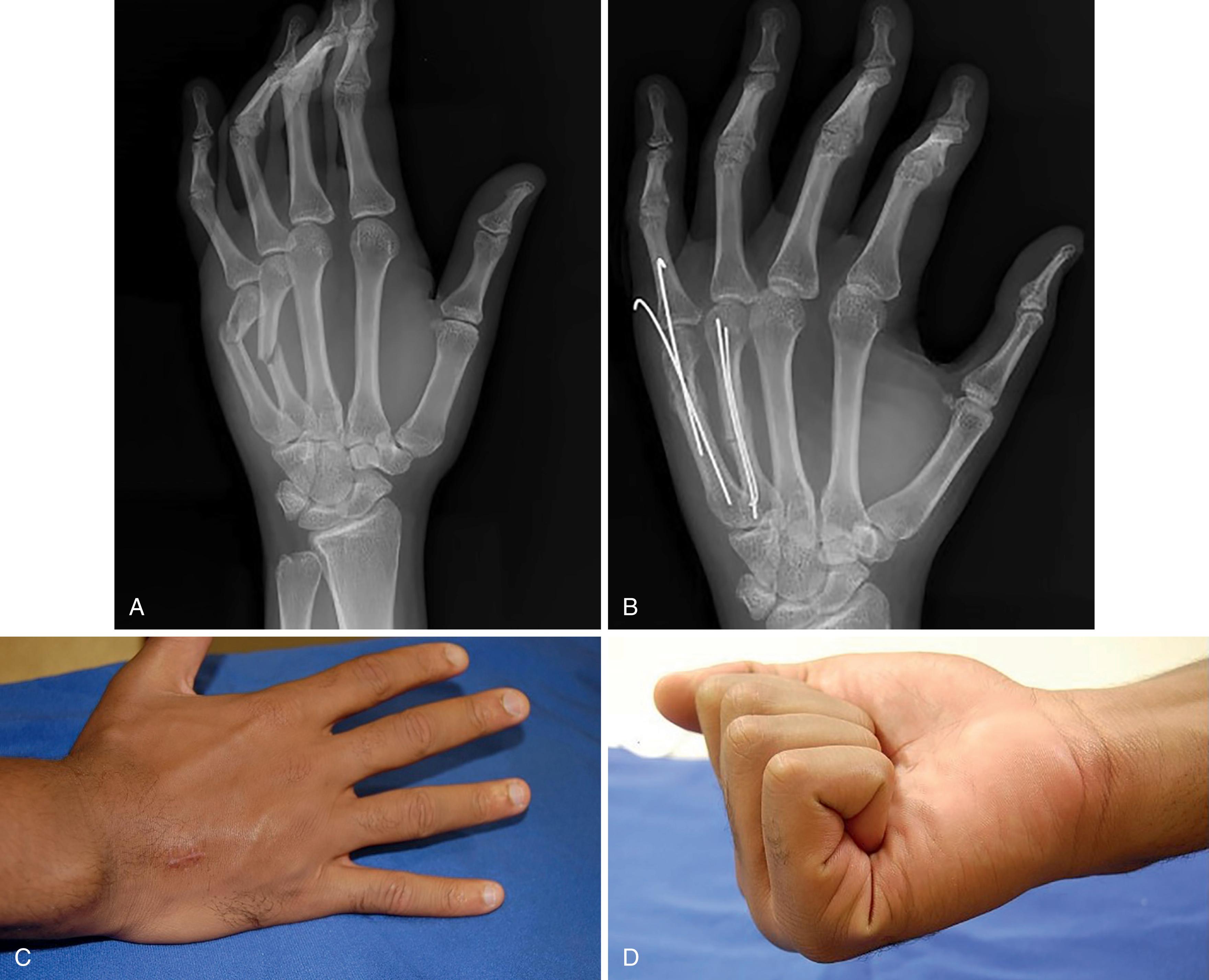
Open reduction is indicated when manipulation fails to restore acceptable rotational alignment or at times for specific patient factors such as intolerance of immobilization. In terms of angulatory malalignment, most studies have failed to demonstrate the superiority of operative treatment for these fractures, and no consensus regarding the upper limits of displacement have been established; therefore surgery should be approached with caution, weighing the risks and benefits carefully. Methods of achieving osseous stability with internal fixation include pinning, IM Kirschner wires, IM screws, or plate fixation.
From a biomechanical standpoint, fixed-angle plating has been shown to provide increased stiffness and stability compared with nonlocked plating, crossed Kirschner wires, and IM screw fixation , ; although clinically, plating is more invasive. IM screw fixation and crossed Kirschner wires have been shown to be biomechanically similar and offer a less invasive approach.
Plate fixation has been used for over 50 years for metacarpal neck fractures. Initial straight plates evolved into an L- or T-plate to maximize fixation in the metacarpal head. , Modern plates with variable angle locking screw clusters offer superior stability of metacarpal head fixation compared with traditional locking and nonlocking plates. They also offer the theoretical clinical advantage of decreased operative dissection, given the clusters of screw holes within a short span. While locking plates provide the necessary rigid fixation to allow early range of motion and good outcomes in many cases, the risk of joint or tendon adherence and hardware prominence that may necessitate removal remain concerns.
Since it was first reported in 2010, IM screw fixation has emerged as a popular technique for managing metacarpal neck fractures. This procedure can be performed through a minimally invasive, extensor-splitting or extensor-sparing approach at the MCP joint with insertion of a retrograde IM screw ( Fig. 7.5 ). Proposed advantages include sufficient biomechanical strength to allow immediate and nonprotected range of motion, minimal soft tissue dissection, lessened risk of tendon adhesions, no prominent hardware, and decreased rate of hardware removal. Recent reports have demonstrated excellent radiographic and clinical outcomes. A 2019 metaanalysis by Beck et al. of nine articles and 169 patients found 100% union, 96% grip strength, 86 degrees MCP flexion, and no serious complications. While this retrograde approach does violate the articular surface of the metacarpal head, this has not been shown to be of clinical significance. Three-dimensional quantitative CT analysis has demonstrated even in maximal MCP extension, only 12% contact exists between the base of the proximal phalanx and the screw entry point given the dorsal insertion site of the screw ( Fig. 7.6 ).
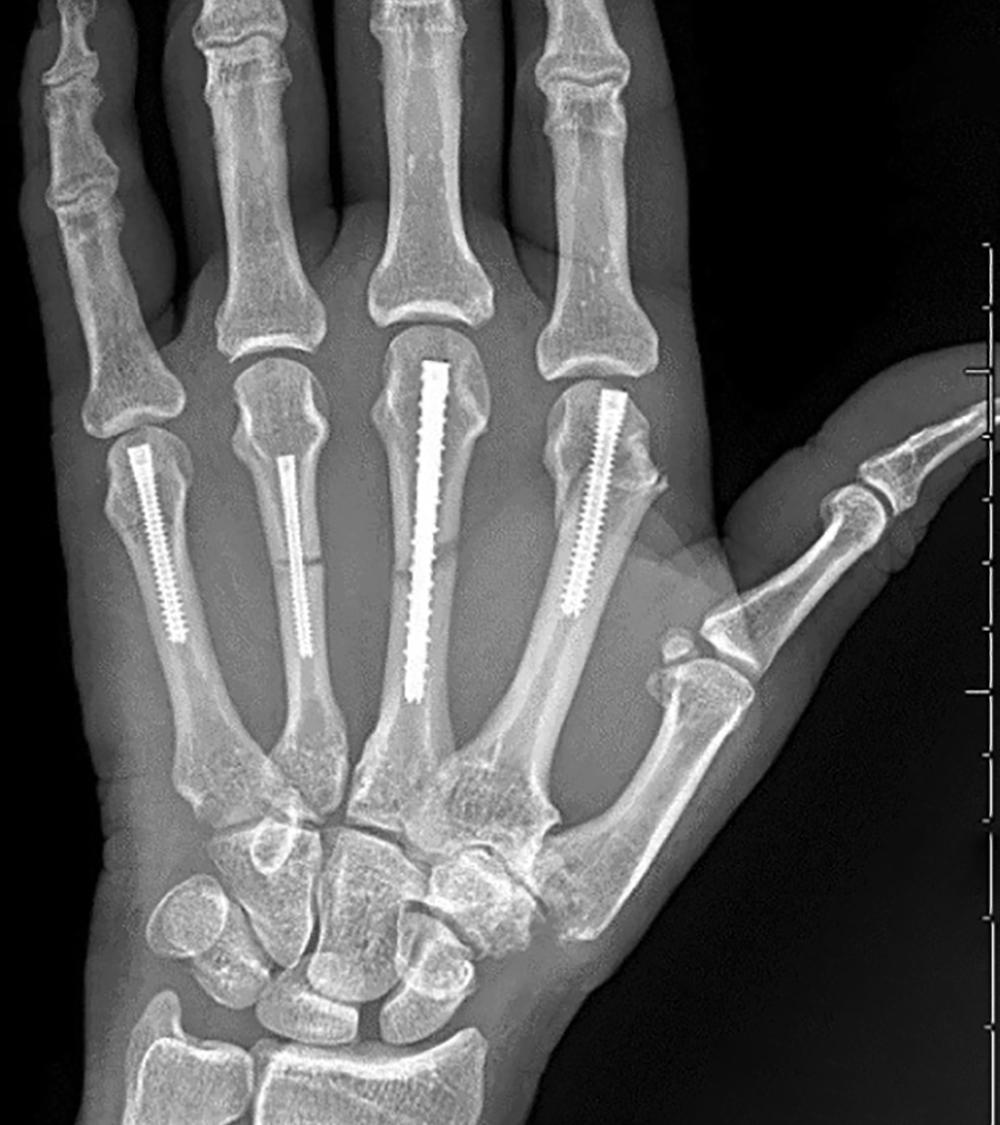
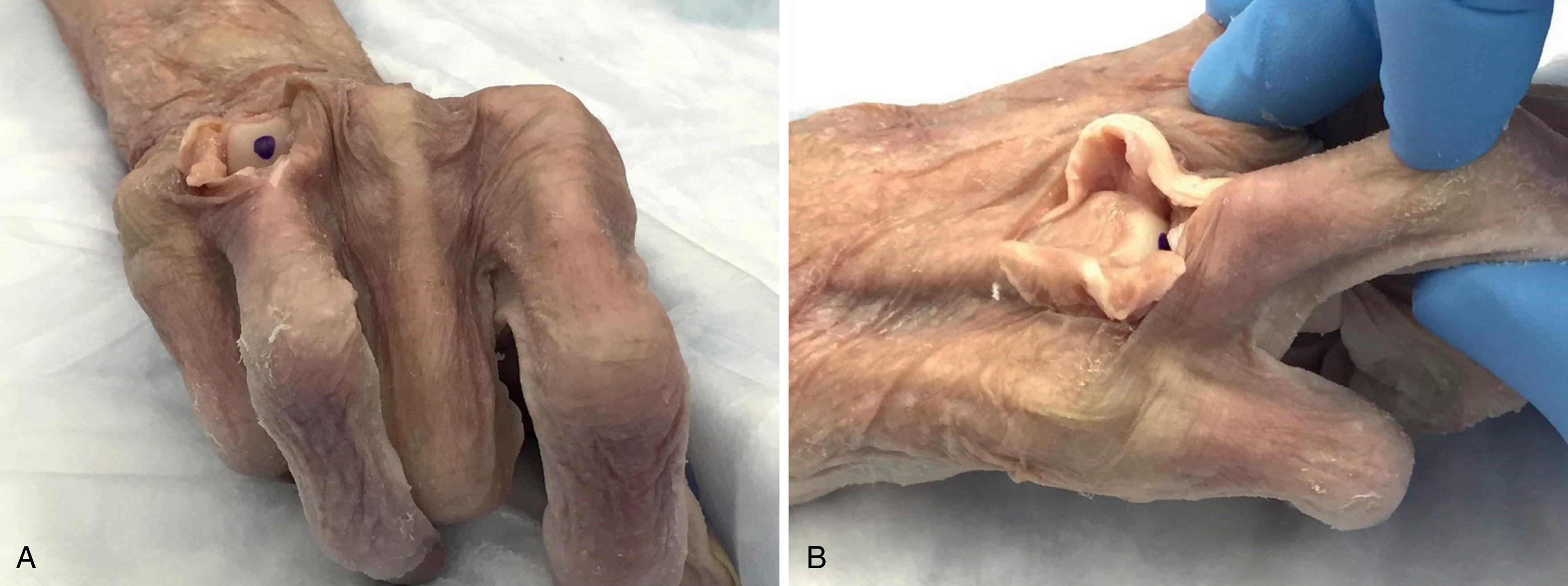
Unless there is significant impairment of motion or pain, a malunion of the fifth metacarpal neck is usually well tolerated. In rare cases of symptomatic malunion, osteotomy can be considered. Hoigne et al. utilized a dorsal closing wedge osteotomy to correct angular malunion and achieved acceptable clinical results but noted metacarpal shortening in all cases. Thurston reported good correction in 9 of 10 metacarpal neck osteotomies with a two-cut “pivot” osteotomy. This combined the benefits of an opening wedge osteotomy (no shortening) and a closing wedge osteotomy (no bone graft or tension on soft tissues). Zhang et al. reported similar success in 21 cases using a simple palmar opening wedge osteotomy secured with three transverse Kirschner wires, cancellous bone graft, and no immobilization.
In most cases, closed metacarpal neck fractures (especially of the ring and small finger) are effectively treated with nonoperative techniques. In the absence of “pseudoclawing” (compensatory MCP hyperextension and PIP flexion) or rotational malalignment, metacarpal neck fractures produce minimal, if any, functional problems despite angulation on the lateral x-ray and shortening in the frontal projection. In terms of rotational malalignment, small degrees of pronation of the small finger or supination of the index finger are well tolerated because they do not cross over adjacent fingers. If no symptomatic malrotation or pseudoclawing is evident, I prefer a functional brace for painful, acute injuries and simple buddy tapes for subacute or delayed presentations as well as less painful acute injuries. A forearm-based dorsal-ulnar gutter splint using thermoplastic material is fabricated such that the wrist is extended 30 degrees and the MCP joints of the ring and small fingers are splinted in approximately 70 degrees of flexion. The proximal phalanges are buddy taped to one another with the IP joints left free. Active range of motion is encouraged. The splint is worn for 2 weeks and is discontinued when pain has resolved.
Reduction of metacarpal neck fractures is clinically indicated when there is “pseudoclawing” or when there is a rotational deformity. A hematoma block or wrist block may be used to achieve anesthesia (see Chapter 1 ). Next, closed manipulation of the metacarpal neck fracture can be performed by the Jahss maneuver (see Fig. 7.3 ). This is accomplished by flexing the MCP and PIP joints to 90 degrees and exerting upward pressure through the flexed proximal phalanx while simultaneously exerting downward pressure on the metacarpal shaft. Particular attention is paid to correcting any rotational deformity by using the flexed proximal phalanx as a crank. A forearm-based ulnar gutter plaster splint is applied to the affected and neighboring digits with the wrist in 30 degrees extension, the MCP joints maximally flexed, and the PIP joints left free. X-rays are then obtained to check the accuracy of reduction, though my preference is to use a mini-C-arm during the procedure. While evidence-based medicine is lacking, generally speaking I have found angulation of 15 to 20 degrees is acceptable for fractures of the index and middle metacarpal necks. Angulation of 30 to 40 degrees is acceptable in the ring finger and up to 70 degrees is acceptable in the small finger. At times, fracture alignment is difficult to attain or maintain with this technique. In those cases, I place patients in finger traps, then reduce and cast the fracture with the MCP joints extended. Immobilization can usually be discontinued at 12 to 14 days, and a program of active range of motion with protective splinting is initiated. The patient may return to sports and unrestricted activity at approximately 6 weeks. Manipulation is not usually worth attempting if the fracture is older than 7 to 10 days.
I consider surgical intervention if closed reduction is unsuccessful or unable to be maintained; also, some patient specific factors lead to a surgical decision (athletes desiring rapid return to play without immobilization, vocational demands intolerant to immobilization, etc.). For the majority of cases I offer two options for surgery: in-office closed reduction and pinning using WALANT or IM screw fixation in the operating room. I discuss with patients that in-office WALANT has the advantage of significant cost savings, no anesthesia-related complications, no need for fasting before surgery, and a proven track record but carries risks of pin site infection, the need for immobilization initially, and in my hands a higher risk of MCP stiffness. In-office surgery begins with injection of approximately 20 cc of 1% lidocaine with 1:100,000 epinephrine buffered with 8.4% bicarbonate (mixed 10:1 ratio). Methods of minimizing injection site pain are well described (see the online chapter “Updates: Tumescent Local Anesthesia for Wide-Awake Hand & Upper Extremity Surgery” at ExpertConsult.com ). Ideally, 25 to 30 minutes is necessary for maximal hemostasis effect to occur, and then the patient is prepped and draped in the usual sterile fashion. The fracture is closed reduced and confirmed with minifluoroscopy, and I prefer two retrograde crossed 0.045-inch Kirschner wires for fixation. Pins may be started transarticular or in the lateral nonarticular portion of the metacarpal head and drilled down the shaft or may exit the cortex proximal to the fracture site. Pins can either be cut outside the skin or buried and the patient is placed in an ulnar gutter splint. I typically begin OT around 1 week for edema control and active range-of-motion exercises with a removable ulnar gutter splint for a month. Pins are typically removed at 3 to 4 weeks.
In my experience, IM screw fixation offers the advantages of immediate range of motion without immobilization, no exposed hardware or the risk of pin site infection, and a more rapid return to sport or work. The procedure is performed in the operating room under either WALANT, regional anesthesia, or general anesthesia. Prior to placing an IM screw, fracture reduction is performed in a closed or limited open fashion. Determination of proper screw diameter and length should then be performed with the screw placed over the skin and measured with radiographs or fluoroscopy. It is critical to ensure that the screw diameter relative to the metacarpal canal diameter is correct. Typically, the ring metacarpal diameter is the smallest and at times is too narrow to permit screw fixation.
With the MCP joint flexed to approximately 90 degrees, I split the extensor tendon over the MCP joint or retract the tendon to one side by releasing a portion of the sagittal band and make a small arthrotomy. Owing to the cam shape of the metacarpal head, the medullary canal will be in line with the dorsal third of the metacarpal head. Fluoroscopy can be helpful to identify the appropriate entry point in line with the canal. The guidewire for the screw is then inserted through the dorsal entry point and across the fracture site ( Fig. 7.7 ). Appropriate screw length can be measured and then the guide wire advanced across the CMC joint to avoid inadvertent removal during drilling. The screw is inserted in a coaxial fashion over the Kirschner wire to a depth approximately 2 mm below the articular surface of the metacarpal head and length adequate to gain purchase within the isthmus of the metacarpal. The extensor tendon is typically repaired with a single absorbable 3-0 braided suture. Typically, a soft dressing is applied with immediate range of motion encouraged.
Angulation >70 degrees in lateral view
Rotatory malalignment (some pronation can be accepted)
Associated fractures in fifth ray or hand
Open fractures with associated soft tissue injury (excluding human bites)
Presence of pseudoclawing (compensatory MCP hyperextension and PIP flexion)
Inquire as to mechanism (human bite)
AP and true lateral x-rays
Assess active range of motion (ROM) and check for presence of pseudoclawing
Less-invasive techniques preferred
Closed reduction and IM screw fixation
Closed reduction and percutaneous pinning
Realize that many patients with this fracture are unreliable and this may compromise outcome.
Reduction accomplished with Jahss maneuver (see Fig. 7.3 )
Screw length and diameter templated under fluoroscopy over the metacarpal
A 1 cm incision made over MCP joint
Extensor split or release ulnar sagittal band
Arthrotomy performed and starting point visualized
Guidepin placed across fracture site down MC shaft
Drill over guidepin and insert screw beneath articular surface
Under fluoroscopic guidance, insert two 0.9-mm retrograde crossed Kirschner pins from the lateral (nonarticular portion of the metacarpal head) into the shaft or may exit the cortex proximal to the fracture site.
Two transverse pins from small to intact ring metacarpal head
“Bouquet” osteosynthesis: percutaneous antegrade insertion of prebent Kirschner pins from small finger metacarpal base into head (see Fig. 7.4B )
ORIF with a minicondylar plate or T-plate
Least desirable treatment option (stiffness may occur)
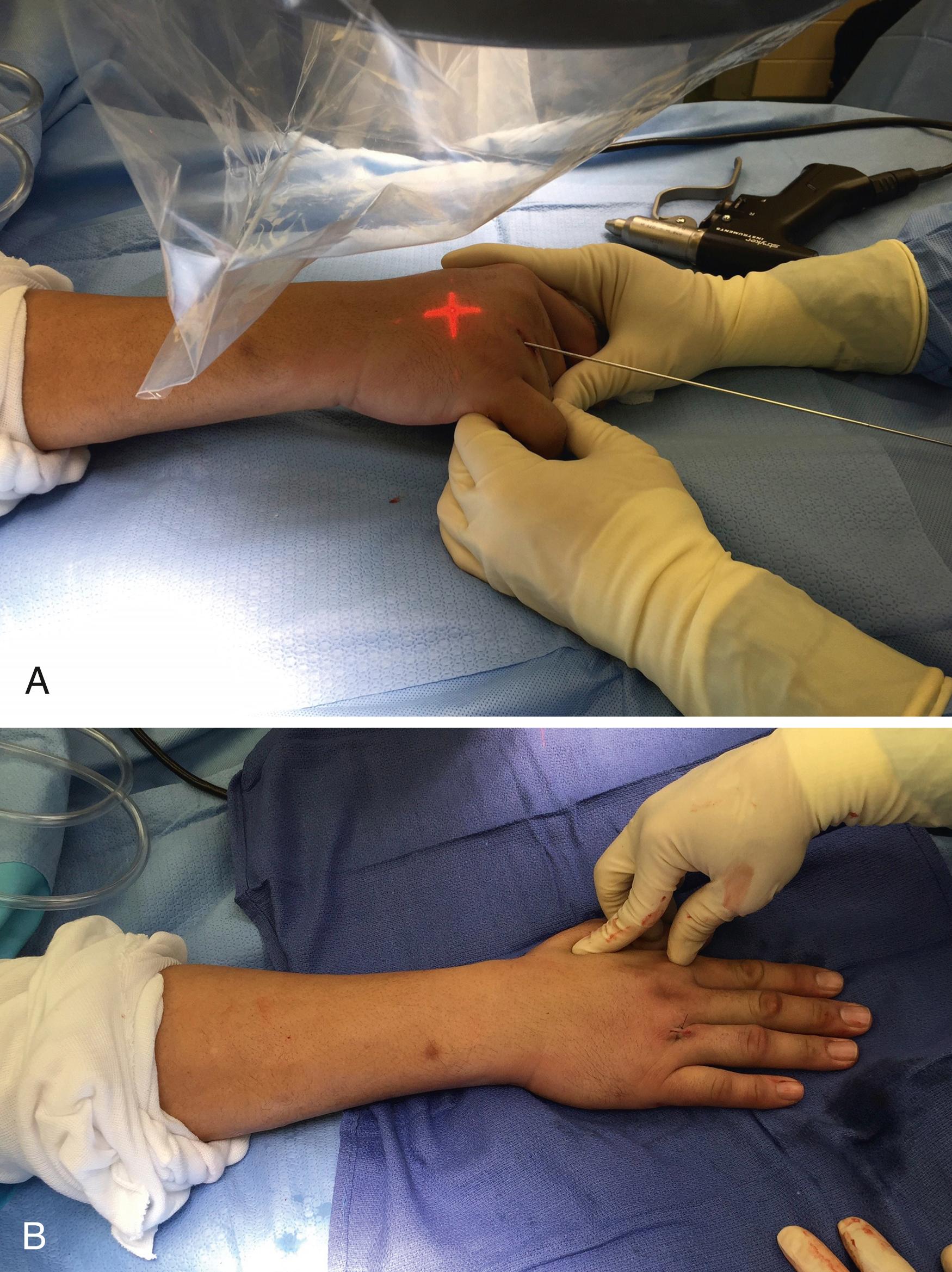
Metacarpal shaft fractures are broadly classified into three types: transverse, oblique (spiral), and comminuted. Each fracture type presents characteristics that may lead to complications if unrecognized or improperly treated.
Although most metacarpal fractures are readily diagnosed with standard biplanar radiographs, oblique views (both in pronation and supination) may be helpful when there is clinical suspicion of a fracture.
Transverse fractures are usually produced by axial loading through the metacarpal head or by a direct blow. The fracture angulates with its apex dorsal; the interosseous muscles provide a flexion moment. Although angulation is generally well tolerated, some patients consider a residual dorsal bump esthetically unacceptable. Angulation in excess of 30 degrees for the small finger, 20 degrees in the ring finger, and any angulation in the middle and index fingers is worthy of reduction.
Oblique and spiral fractures are usually the result of torsional forces and can cause rotational malalignment. Five degrees of malrotation in a metacarpal fracture can cause 1.5 cm of digital overlap.
Malrotation is poorly tolerated and difficult to assess on plain x-rays and is best judged clinically by asking the patient to simultaneously flex all fingers. If clinical assessment is limited by pain, a fracture block with local anesthesia can be used to aid in the evaluation. Royle assessed rotation by placing the palm flat and measuring the fingernail with respect to the horizontal plane. If it was greater than 10 degrees, operative intervention was usually necessary. If scissoring is present with composite digital flexion, open reduction must be considered.
Comminuted fractures are usually produced by direct impact, are often associated with soft tissue injury, and may produce shortening. There is considerable controversy as to the degree of shortening that may be accepted. Cadaveric studies have demonstrated that for every 2 mm of shortening, a 7-degree extensor lag is produced and that digital flexion force is affected with shortening beyond 5 mm. Clinical studies, however, have demonstrated excellent recovery of both digital extension and grip strength following traumatic metacarpal shortening of even up to 10 mm. , Regardless of fracture geometry, certain fracture types may influence the surgeon to perform operative fixation. These include injuries to multiple digits (especially spiral or oblique), fractures of the border (index and small) digits, open fractures (especially those with bone loss or concomitant soft tissue injury), and fractures in polytrauma victims who cannot cooperate or tolerate cast immobilization.
Closed reduction with immobilization works well for the majority of metacarpal shaft fractures, and overtreatment is to be avoided. Many metacarpal fractures are inherently stable and may be treated with minimal or no immobilization. For example, in athletes, Rettig et al. reported that 82% of the fractures were minimally displaced or nondisplaced and the average time lost from practice or competition was only 13.7 days. McMahon et al. treated stable metacarpal fractures with either a compression glove or 3 weeks of immobilization. Although the final ranges of motion were comparable, those in the elastic garment had better mobility and less swelling. Wright observed that over 60% of patients with fractures of metacarpals that were immobilized for more than 3 weeks had significant loss of hand function. When short-term casting is employed, the wrist is placed in slight extension, MCP joints flexed, and the PIP joints are extended. The hand assumes the intrinsic-plus or “clam-digger” position ( Fig. 7.8 ). This position limits joint contractures and maintains the intrinsics in a relaxed position. Functional braces have been designed to provide three-point fixation of the fracture and allow mobility of the wrist and fingers. Some have found braces ineffective and others found that if the brace was applied too tightly, skin necrosis could occur.
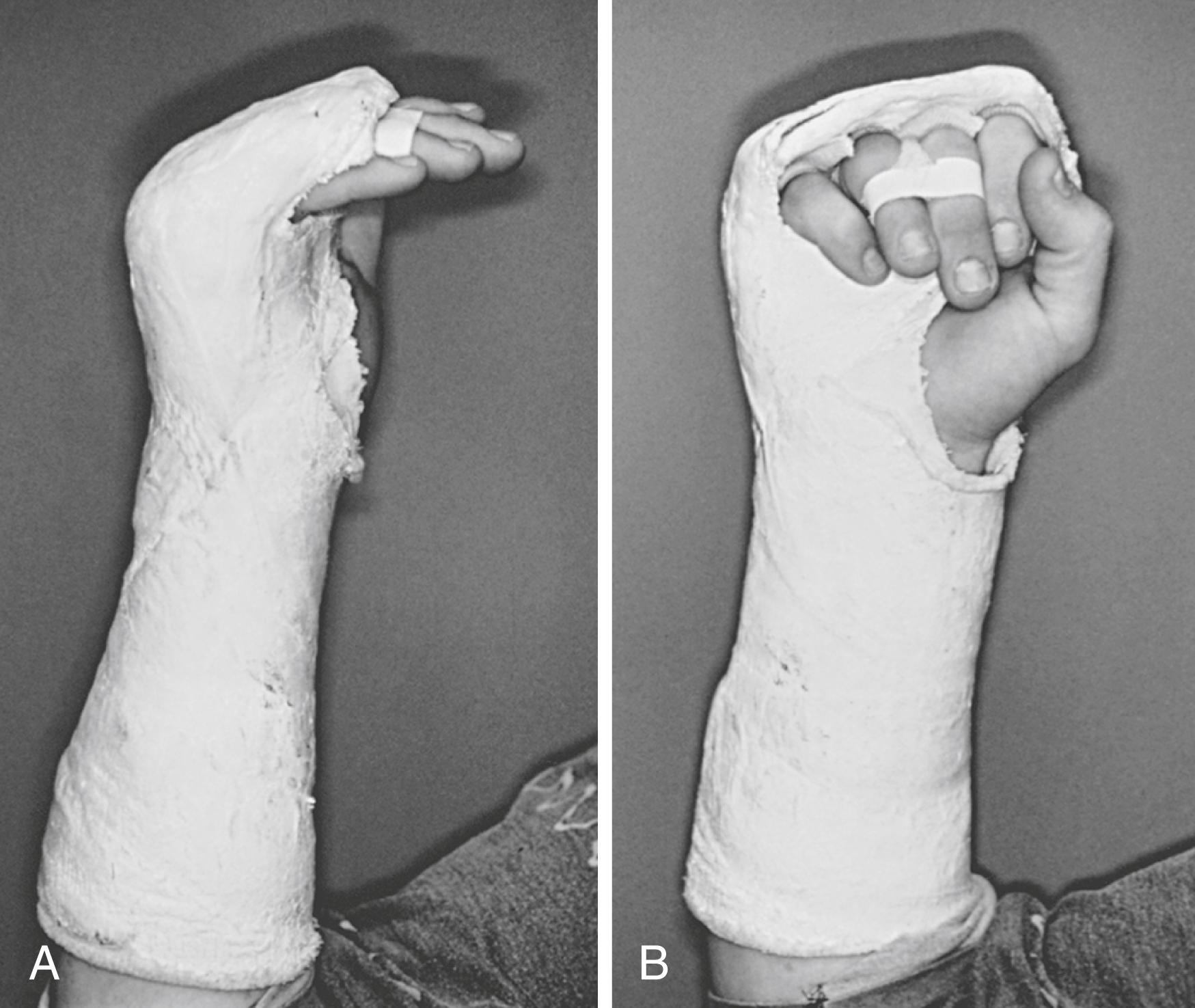
Closed reduction and percutaneous pinning remains a time-tested and acceptable technique for the management of metacarpal fractures, and recent studies continue to demonstrate acceptable functional outcomes, low DASH scores, and high union rates. , Kirschner wires may be used in nearly any fracture pattern ( Fig. 7.9 ). Kirschner wire fixation is technically easy, requires minimal dissection, and is universally available. Wire configurations can be either single or multiple and may be crossed, transverse, longitudinal (IM described above), or in combination. They can be used to supplement other forms of fracture fixation and can also be used as a “bailout” if more complicated fixation has failed. On the other hand, Kirschner wires are not rigid, may loosen or even migrate, and have the potential to distract fracture fragments. Furthermore, pin tract infections may develop secondary to skin irritation or loosening, and pin protrusion may make therapy and splintage awkward. Alan Freeman aptly stated that Kirschner wires first penetrate, then incinerate, then irritate, and finally suppurate (personal communication). Botte et al. reviewed a series of 422 Kirschner wires placed in the hand and wrist and reported an 18% complication rate. In a series of 590 Kirschner wire fixations, Stahl and Schwartz noted a 15.2% complication rate. The majority were classified as minor (pin loosening, infection, or bending); however, 1.7% were major (osteomyelitis, tendon laceration, or nerve injury). There was no difference between protruding or buried pins. Most of the complications were not serious, and permanent sequelae were infrequent.
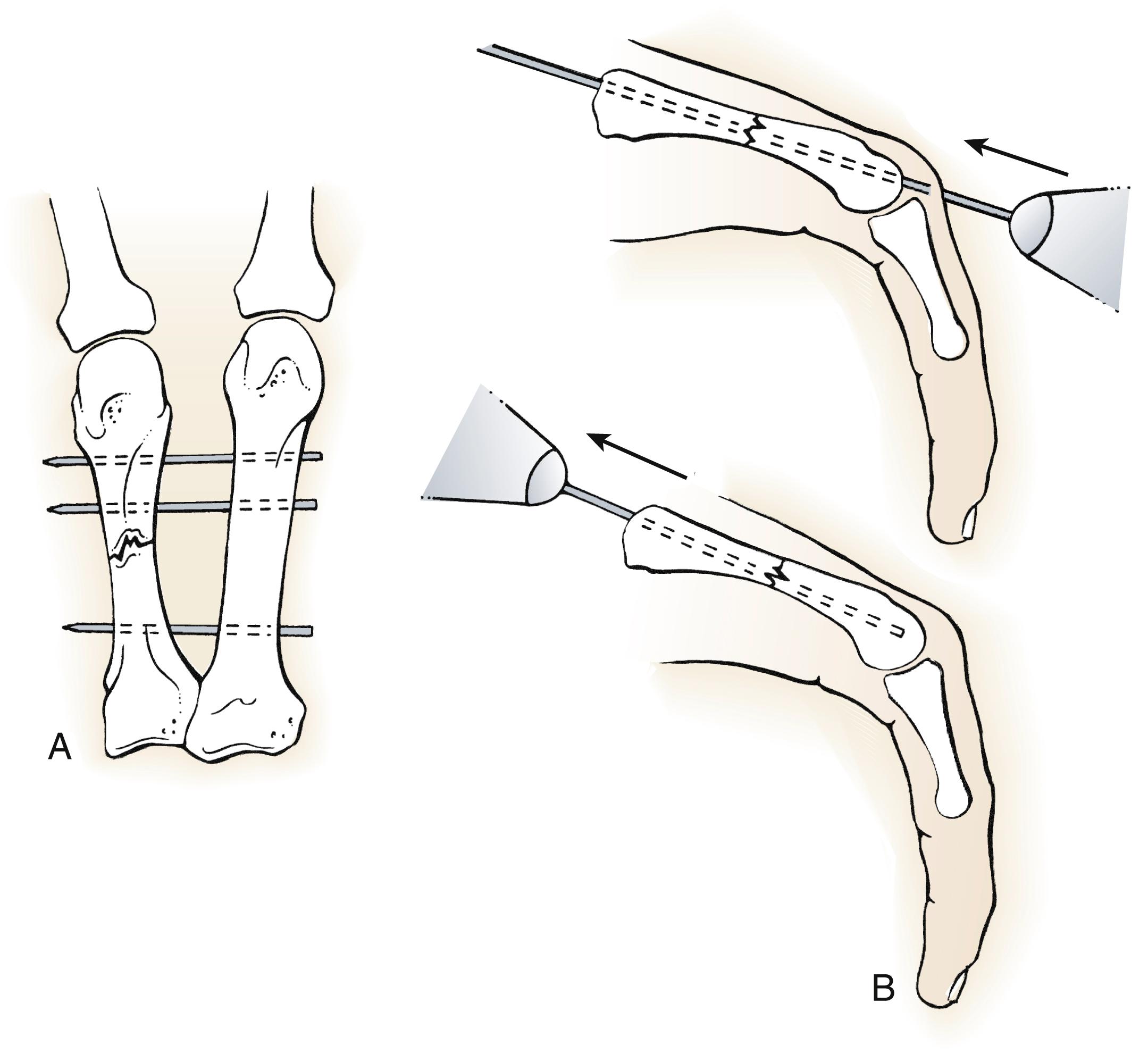
For longitudinal fixation, the pin can be drilled in retrograde fashion from the fractured end out the dorsoradial aspect of the metacarpal head and then back down the shaft through the reduced fracture. Following fracture reduction, a pin can also be introduced directly into the metacarpal head on either side of the extensor tendon and driven down the metacarpal shaft to engage subchondral bone at the CMC joint. Transarticular pins are generally bent outside the skin and left in place for 3 weeks. An alternative, but technically more difficult, method is to percutaneously introduce the Kirschner wire through the lateral aspect of the metacarpal head in the area of the collateral ligament origin and then down the shaft. This technique is indicated primarily for transverse and short oblique shaft fractures. A recently described technique of combining percutaneous pinning with an external connector to enhance construct stability has been described demonstrating comparable results to plating and IM pinning. ,
To avoid complications related to a protruding pin or extensor tendinopathy, IM Kirschner wire fixation for unstable metacarpal fractures was introduced. , IM fixation is applicable for transverse and some oblique fractures, is easy to perform, allows for early active motion, and makes secondary removal unnecessary. Often this can be performed in a percutaneous or limited open fashion; however, open reduction is required if an acceptable reduction cannot be obtained. In 1981 Grundberg reported one nonunion in 27 metacarpals treated by open reduction and permanent IM fixation with a large Steinmann pin. Potential disadvantages include rotational instability, pin migration, and occasional fracture distraction. The technique is particularly ill-suited for spiral or long oblique fractures given their inherent rotational instability.
In an effort to better control rotation, a technique of closed IM pinning using multiple 0.8-mm flexible pins or Kirschner wires was developed ( Fig. 7.10 ). For this technique a cortical window is made using an awl in the ulnar base of the fifth metacarpal or 1 cm distal to the CMC joint for the radial three metacarpals. Two to four Kirschner wires can be used. The sharp tip can be removed and a slight bend placed wire to facilitate passage into the medullary canal. The wires are then advanced across the fracture site and seated into the subchondral bone of the metacarpal head. These pins can then be cut flush with the dorsal cortex to avoid extensor tendon irritation. Advantages include the ability to perform the procedure in a closed or limited open fashion and the ability to secure rotational control through three-point fixation.
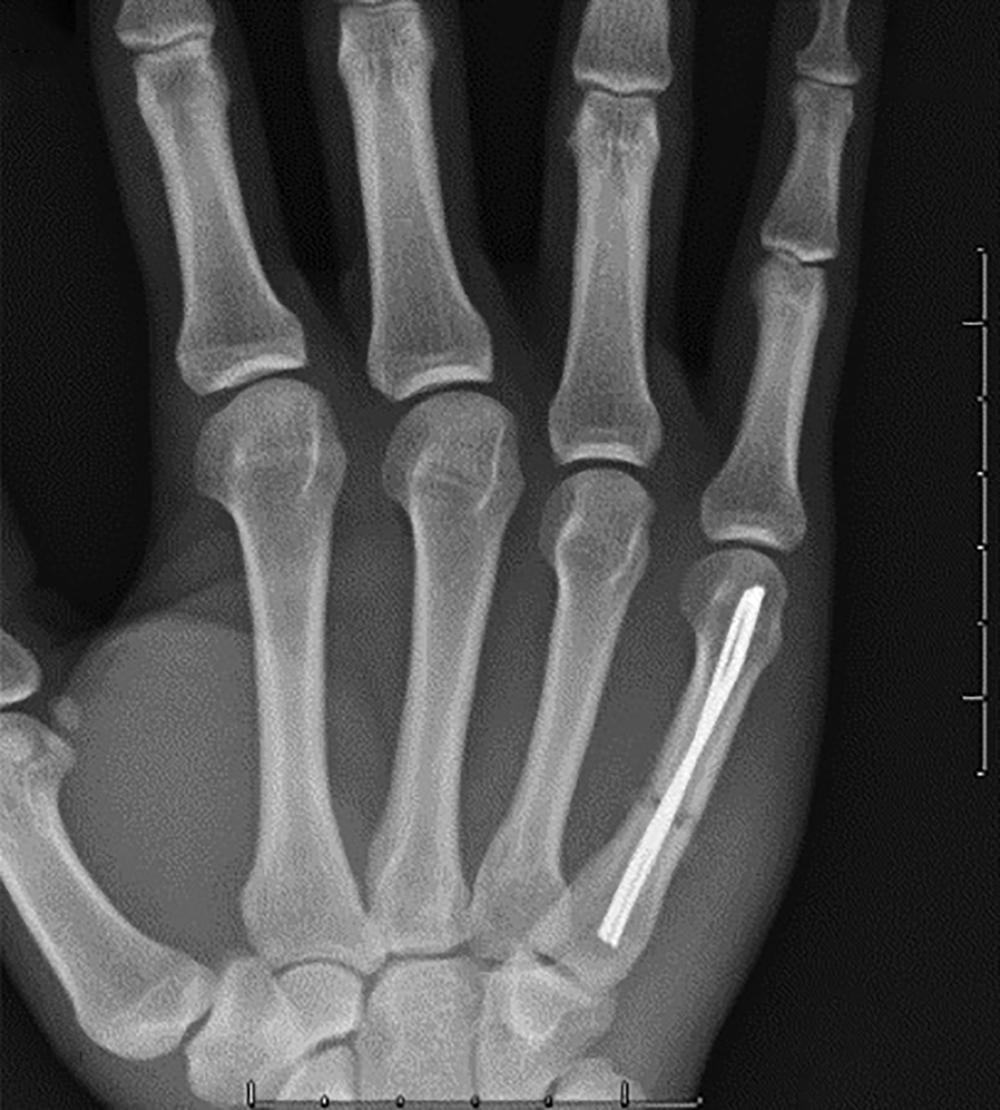
Biomechanically, a single larger diameter (1.6 mm) pin has been demonstrated to be superior to three 0.8 mm wires in resisting cantilever stress though the rotational stability was not compared. Posner advised against IM fixation, in the belief that it does not control rotation and may produce secondary scarring in the extensor hood. In an effort to enhance rotational stability, eliminate external hardware and utilize minimally invasive techniques, IM unlocked and locked nails were introduced. Biomechanically the IM nails have been shown to be equivalent to crossed Kirschner wires. In a review of 55 cases, Mirza et al. achieved union and full range of motion in all cases; however, revision surgery for device removal was required in all cases. Clinical reports have demonstrated the ability of locked IM nails to maintain length, alignment, and rotation even in comminuted fractures secondary to gunshot wounds. Limitations of this technique include the need for implant removal, penetration of the MCP joint, extensor tendon irritation, and at times loss of reduction.
More recently, the use of IM screw fixation for metacarpal shaft fractures has gained popularity. The surgical technique is identical as described above for metacarpal neck fractures. From a biomechanical perspective, IM screw fixation has been shown to be superior to Kirschner wire fixation and inferior to plate and screw fixation with respect to ultimate tensile strength and four-point bending resistance. , Numerous studies, including a literature review of 169 fractures, have reported near full range of motion, 100% union rates, grip strength approaching 100% on the contralateral side, and excellent patient-reported outcomes using this technique. , , , , When compared directly to IM Kirschner wires in two separate studies, IM screws were found to have a faster return to work and lessened period of immobilization but no difference with respect to the ultimate range of motion, grip strength, or DASH. , Limitations of the technique include increased cost relative to Kirschner wires and the potential for refracture or hardware deformation following subsequent trauma.
Indications for open reduction of metacarpal shaft fractures vary widely. Melone noted that approximately 10% of phalangeal and metacarpal fractures were irreducible by closed manipulation or percutaneous pinning and thus required open reduction. Commonly accepted indications for open reduction include the following:
Open fractures —particularly those with associated bone loss, soft tissue injury, or additional regional fractures.
Multiple fractures —in such cases the stabilizing effect of the adjacent metacarpals may be lost. That said, not all patients with multiple metacarpal fractures, especially those with minimal displacement, require surgical intervention.
Unstable fractures —especially those that cannot be satisfactorily held by closed or percutaneous techniques. Fractures of the border metacarpals tend to be more unstable and more difficult to control than fractures of the central metacarpals because of the lack of soft tissue support on both sides. Freeland and colleagues pointed out that there is a difference between rigid and stable fixation. Rigid fixation is usually unnecessary; however, fixation must be sufficiently stable to promote fracture union and early rehabilitation.
Malalignment —rotational malalignment resulting in digital overlap is unacceptable and is characteristically seen in spiral and oblique fractures. When correction of a rotational deformity by closed techniques or percutaneous pinning is unsatisfactory, open reduction is often indicated.
Dorsal angulation, characteristic of transverse fractures, is better tolerated, particularly when the fracture involves the ring and small metacarpals or when the fracture is in the distal end of the shaft. Dorsal angulation has several undesirable effects that may lead to the decision for open reduction:
The metacarpal head becomes prominent in the palm and may cause pain on grasping.
There may be compensatory hyperextension at the MCP joint that results in a secondary intrinsic weakness and a pseudoclaw deformity in extension.
Patients find the dorsal prominence esthetically displeasing.
In contrast to the phalanges, dorsal angulation does not seem to interfere with extensor tendon excursion. Flatt accepted up to 35 degrees angulation in the ring and little metacarpals, but not over 10 degrees in the second and third metacarpals. Smith and Peimer and Freeland et al. recommended open reduction if the angulation could not be corrected to under 10 degrees in the second and third metacarpals and under 20 degrees in the fourth and fifth metacarpals. Opgrande and Westphal believed that no angulation should be accepted in fractures of the second and third metacarpals.
Likewise, opinions vary as to the degree of acceptable shortening. Wolfe and Elliott mathematically demonstrated that with the same degree of angulation, there is more shortening in shaft fractures than metacarpal neck fractures. Butt and Bloem believed that shortening, even up to 1 cm, was well tolerated without functional impairment. Workman, however, attributed weakness of grip to metacarpal shortening in the belief that the relative decreased length of the musculotendinous unit decreased its efficiency. Eglseder et al. demonstrated an average of 3.1 mm of shortening in patients treated for isolated ring metacarpal fractures whether they underwent operative or nonoperative treatment and demonstrated no clinical differences between groups. FLOAT NOT FOUND
| Technique | Indications | Advantages | Disadvantages |
|---|---|---|---|
| Kirschner wires | Transverse | Available and versatile | Lacks rigidity |
| Oblique | Easy to insert | May loosen | |
| Spiral | Minimal dissection | May distract fracture | |
| Longitudinal | Percutaneous insertion | Pin tract infection | |
| Requires external support | |||
| Splint and therapy awkward | |||
| Intraosseous wires | Transverse fractures (phalanges) | Available | May cut out (especially osteopenic bone) |
| Avulsion fractures | Low profile | ||
| Supplemental fixation (butterfly fragment) | Relatively simple | ||
| Composite wiring | Transverse | More rigid than Kirschner wires | Pin or wire migration |
| Oblique | Low profile | Secondary removal (sometimes) | |
| Spiral | Simple and available | Exposure may be significant | |
| Intramedullary device | Transverse | No special equipment | Rotational instability |
| Short oblique | Easy to insert | Rod migration | |
| No pin protrusion | |||
| Minimal dissection | |||
| Interfragmentary fixation | Long oblique | Low profile | Special equipment |
| Spiral | Rigid | Little margin for error | |
| Plates and screws | Multiple fractures with soft tissue injury or bone loss | Rigid (stable) fixation | Exacting technique |
| Markedly displaced shaft fracture (especially border metacarpals) | Restore or maintain length | Special equipment | |
| Articular and periarticular fractures | Extensive exposure | ||
| Reconstruction for nonunion or malunion | May require removal | ||
| Refracture after plate removal | |||
| Bulky | |||
| External fixation | Restore length for comminution or bone loss | Preserves length | Pin tract infections |
| Soft tissue injury or loss | Allows access to bone and soft tissue | Osteomyelitis | |
| Infection | Percutaneous insertion | Overdistraction: nonunion | |
| Nonunion | Direct manipulation of fracture avoided | Neurovascular injury | |
| Fractures through pin holes | |||
| Loosening |
A combination of Kirschner wires (0.035- or 0.045-inch diameter) and monofilament stainless steel wire (24- or 26-gauge) can also be used to further enhance construct stability ( Fig. 7.11 ). The monofilament stainless steel wire is inserted as a tension band through a small transverse drill hole in the distal fragment and crossed around the Kirschner wires at the bone interface proximally. Composite wiring provides additional stability and fracture compression and superior strength, stiffness, and approximation compared with crossed Kirschner wires alone. , Little, if any, additional dissection is necessary in the setting of open reduction. The technique is rigid enough to allow early motion. Greene et al. reported excellent mobility after fixation of 33 metacarpal fractures and no cases of reduction loss, nonunion, or tendon rupture. The technique is contraindicated when there is bone loss, comminution, or osteopenia. Care must be taken not to excessively tighten the wire, as this leads to wire breakage.
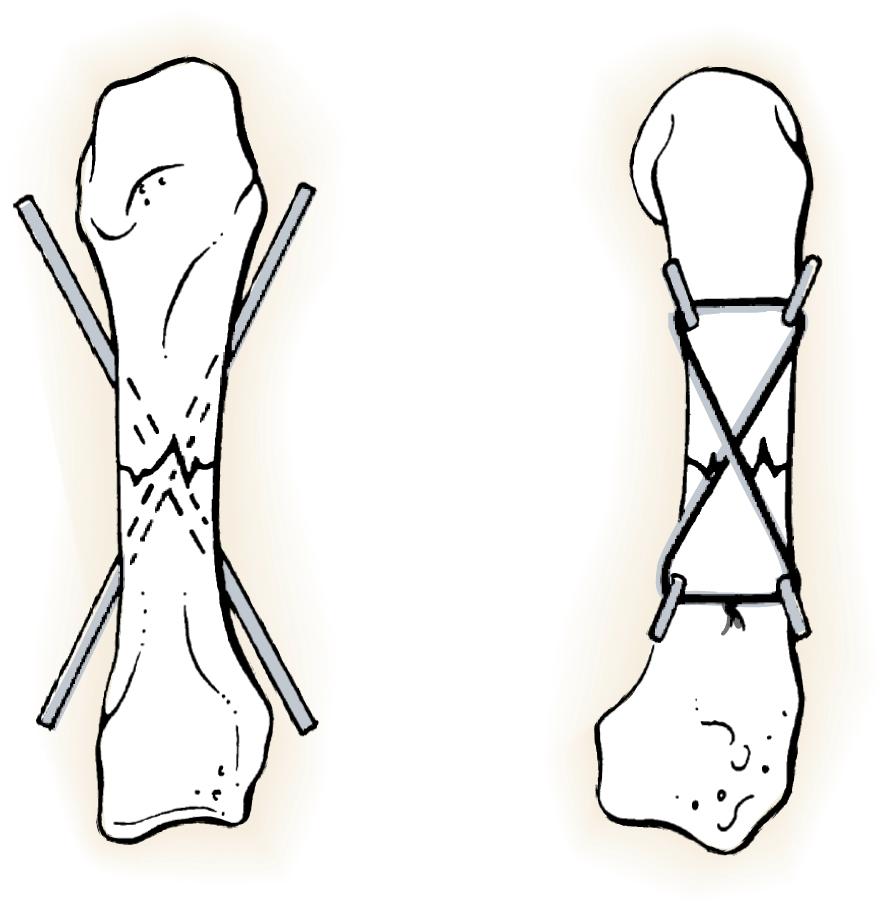
Gropper and Bowen reported cerclage (circumferential) wiring with 24-gauge stainless steel wire for oblique and spiral metacarpal shaft fractures. Excellent results were reported in 21 fractures, but this technique has not gained popularity. Gingrass et al. achieved six excellent or good results in seven metacarpal fractures treated by double 26-gauge interosseous wires placed in a dorsal-volar direction. A single Kirschner wire was added if the fixation was unstable or bone loss was present (5 of 7 cases). Haas and Savage reported successful treatment of two oblique metacarpal shaft fractures with 0 nylon cerclage sutures in a patient with severe asthma and metal allergies. Interosseous wiring done without supplemental Kirschner wire fixation is generally not suitable for metacarpal shaft fractures inasmuch as wire loosening and subsequent loss of reduction are real possibilities; however, the technique can still be useful to augment other forms of fixation ( Fig. 7.12 ).
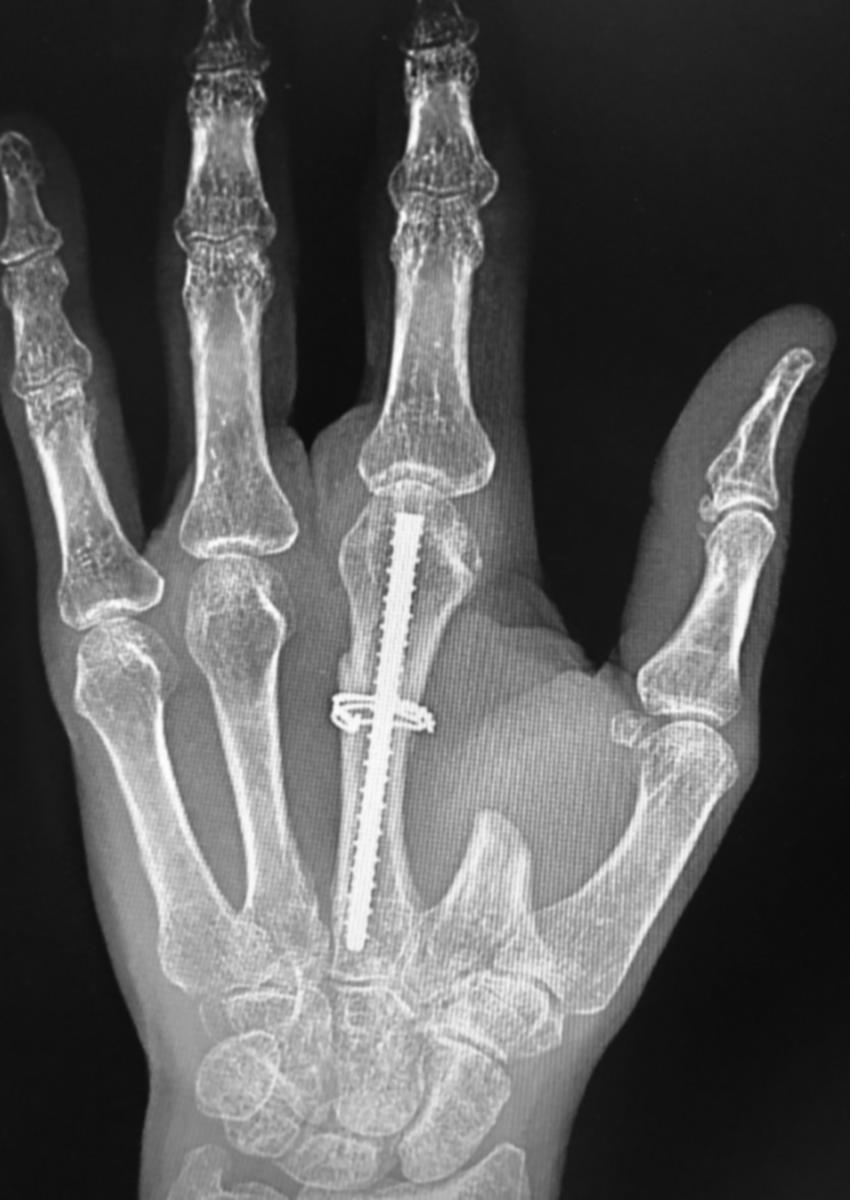
Interfragmentary compression screws provide rigid fixation and are primarily indicated for long oblique and spiral shaft fractures ( Fig. 7.13 ). To ensure success, the fracture length must be a minimum of twice (and ideally three times) the bone diameter. Technically, there is little margin for error. Interfragmentary compression is accomplished when a screw is passed through a gliding hole (nonthreaded and of wider diameter than the threads of the screw) into the far fragment (tapped to the same diameter as the screw threads) such that as the screw is tightened (lagged), the threads grip and draw the far fragment toward the near fragment until compression is achieved. Reduction of the fracture by manipulating it into alignment and holding the reduction with a specialized clamp must be achieved before attempting interfragmentary compression ( Fig. 7.14 ).
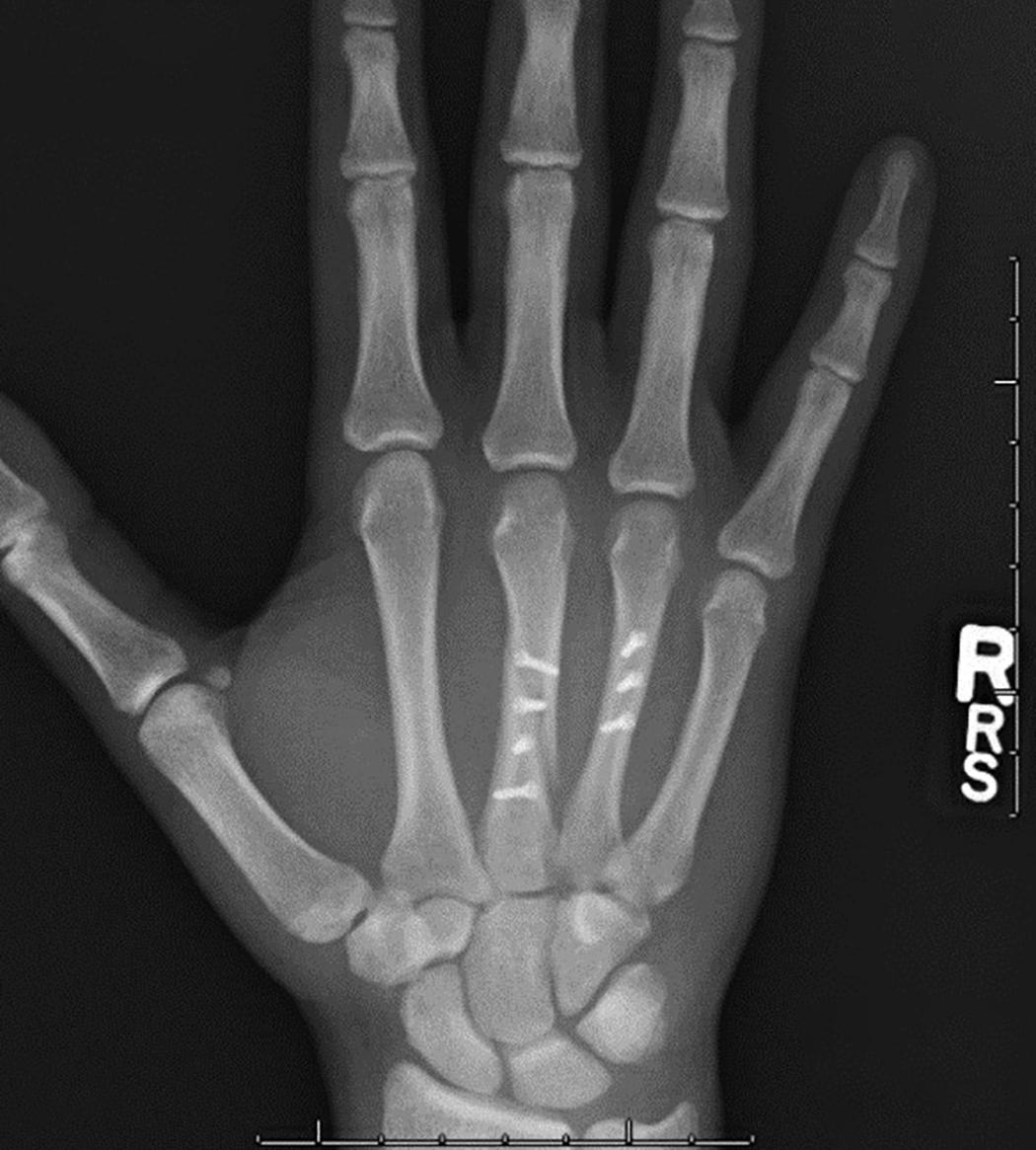
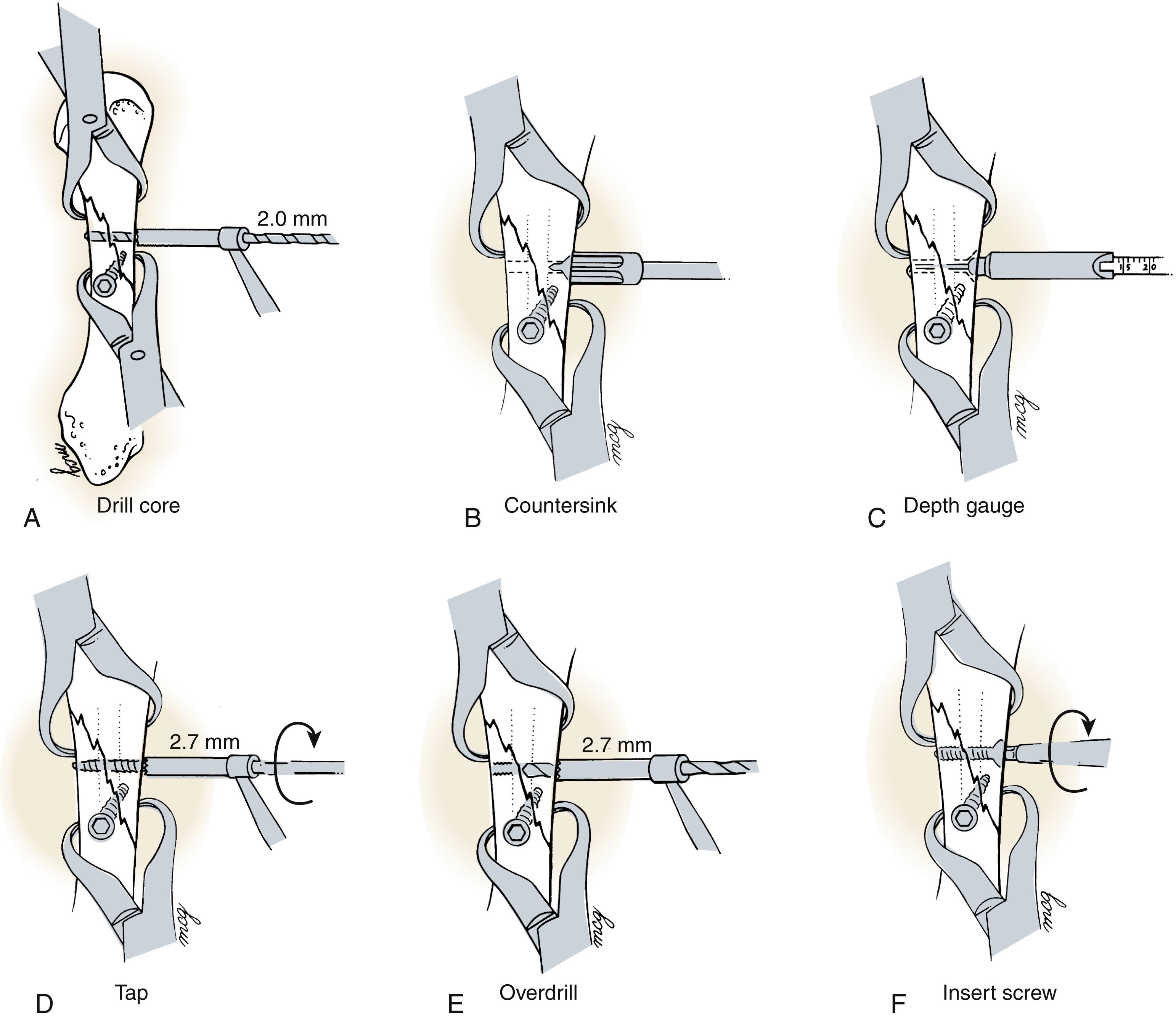
Ideally, longitudinal compressive (axial) forces are best counteracted by placing the screw 90 degrees to the bone’s long axis, and torsional stresses are best resisted by placing the screw 90 degrees relative to the plane of the fracture. To resist both axial and torsion loading, the screw should be placed in a plane bisecting the fracture plane and longitudinal axis. In large patients, at least two 2.7-mm screws are necessary, and in smaller individuals, three 2.4-mm or 2.0-mm screws are necessary. To avoid fragmentation, the screw hole should be a minimum of two screw diameters from the fracture margin. Successful outcomes have been reported by numerous surgeons with this technique. ,
Interfragmentary screw fixation (2.7 mm) of a metacarpal fracture involves six sequential steps (see Fig. 7.14 ). There is little tolerance for error with this technique; it is critical that the screw engage the far cortex to lag and hence compress the fracture. If the screw is inserted through the near cortex and is misdirected such that it hits the endosteal surface of the far cortex, the fracture will splay apart and reduction will be lost. Hence any resistance to screw insertion should alert the surgeon to stop and redirect the screw so that reduction is not lost.
In 1970 Simonetta listed indications for plate fixation of the metacarpal shaft: multiple fractures, especially those with soft tissue injury; isolated, unstable transverse fractures; malunions; and pseudarthrosis. Others , used plates to span defects when there was bone loss requiring grafting. In so doing, the plates provided enough stability so that early mobilization could be initiated, thus minimizing articular stiffness and trophic changes, especially in older patients. In several reports, plate and screw fixation of metacarpal shaft fractures have shown good to excellent results. Stern and colleagues reported complications in fractures treated with metacarpal plating. Complications included malunion, nonunion, and stiffness (articular and tendon adhesions). Complications were more frequent when there was associated bone loss, soft tissue injury, and open fractures.
Most implants are made of either stainless steel or titanium. Although titanium is more expensive, Lowka notes some advantages of titanium, including absence of corrosion or allergic reactions, ease of contouring, and a theoretical advantage of a modulus of elasticity that approaches bone. Great care must be taken when using titanium implants, as screws may break, especially when being removed, and plates can break if excessively contoured prior to application. Plate and screw fixation has been demonstrated to be biomechanically superior to both IM screw fixation as well as crossed Kirschner wires in several studies with respect to load to failure under bending loads. , , One should keep in mind that the minimum strength for stable fixation in the clinical setting has never been determined; hence biomechanically inferior constructs may be perfectly suitable in some circumstances.
Currently, newer generation maxillofacial plating systems offer variable angle, precontoured, locking plates often with variable angled locking screw clusters. These designs allow for a greater number of locking screws to be placed over a shorter distance, thus minimizing the required dissection needed to achieve adequate secure internal fixation ( Fig. 7.15 ). , Screws are self-tapping and diameters range from 0.8 to 1.7 mm. Because the plates are low profile (approximately 1.0 mm), the periosteum can often be closed with less tendency for adhesion formation. Many systems also offer the benefit of in situ bending of the plates to enable correction of residual malalignment after plate application. While excess bending should be avoided to prevent fatigue failure of the metal, small angulation or rotational deformities can be corrected after placing provisional fixation. Fracture stabilization, although not rigid, is adequate to allow early mobilization with a low incidence of hardware failure.
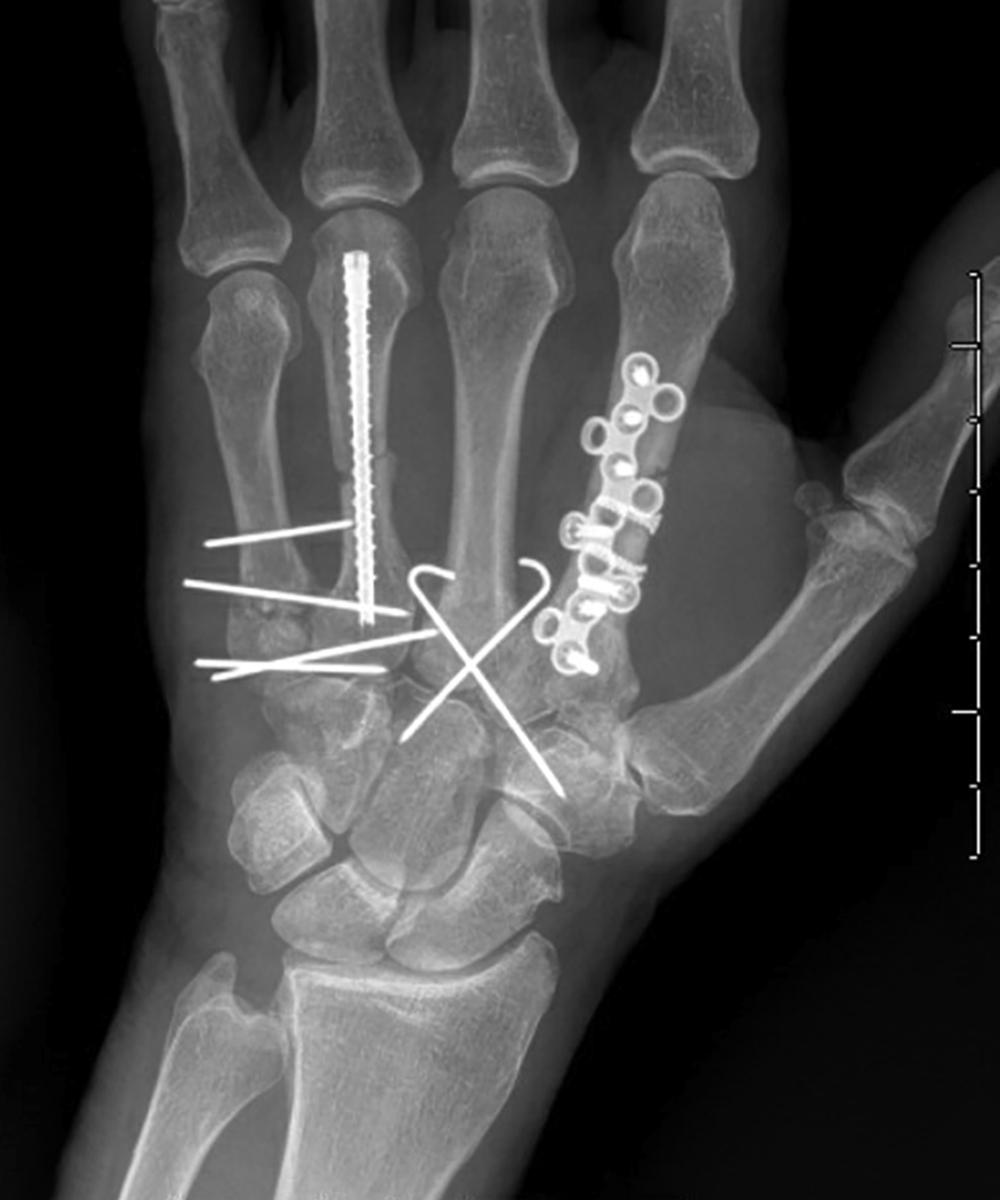
External fixation is indicated as temporary or definitive fixation for severe fractures when anatomic reconstitution of the skeleton is not feasible ( Fig. 7.16 ). Examples include highly comminuted open shaft fractures with or without bone loss; displaced, comminuted articular fractures; and fractures with injury or loss of soft tissue structures. In addition, external fixation can be used to stabilize septic nonunions when it is necessary to remove infected bone.
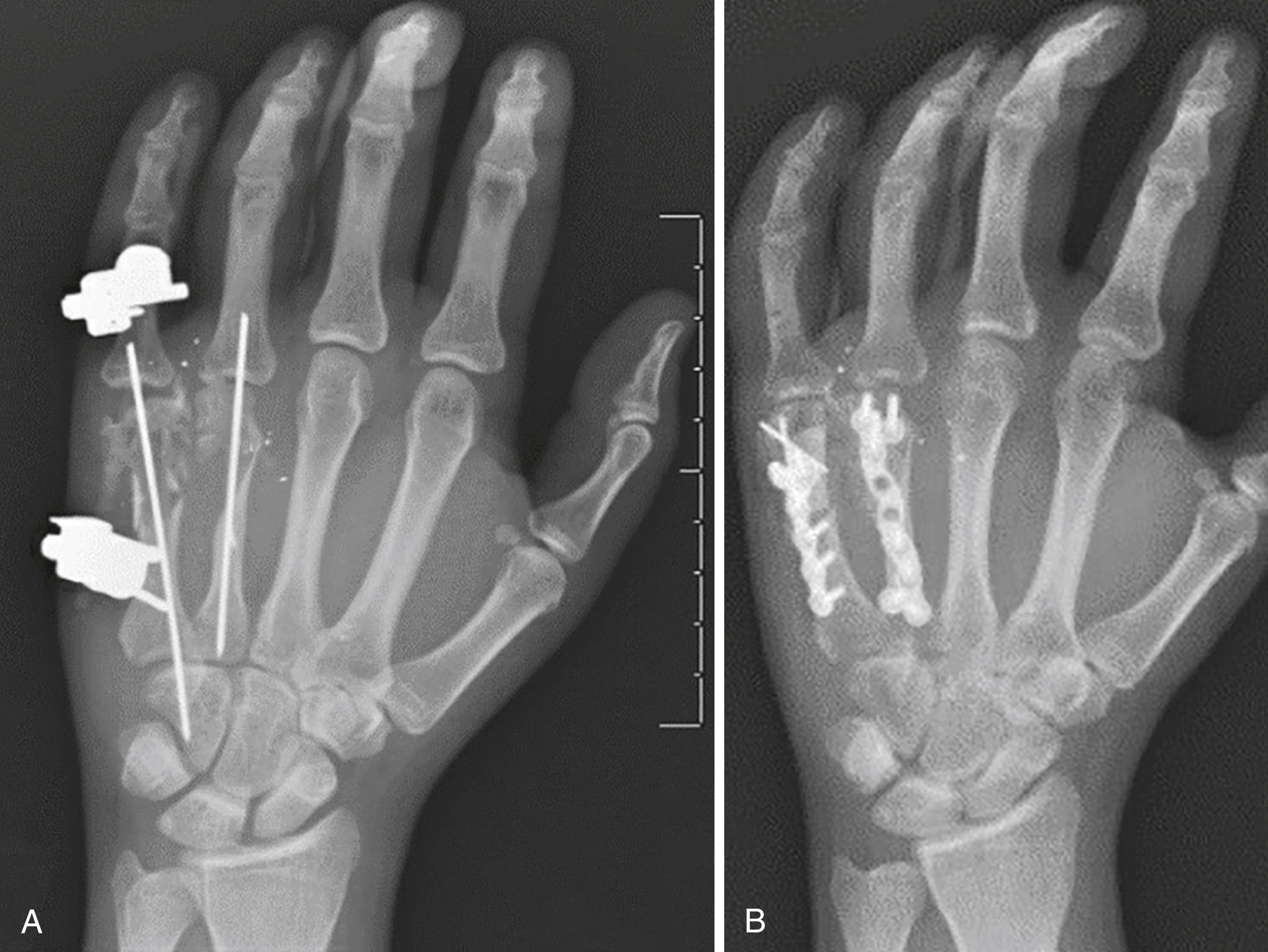
The advantages of external fixation were enumerated by Schuind et al. : “There is respect of bone biology.” Fracture fragments are not stripped of periosteal blood supply and further devascularized. External fixation does not cause the amount of osteopenia seen with more rigid systems such as plating; however, there is adequate stability to permit early mobilization. External fixators are adjustable, and a second reduction can be carried out if the initial reduction is unstable or has secondarily shifted. When there has been concomitant soft tissue injury, external fixation permits ready access to the wound for debridement as well as for reconstruction of tendons, nerves, and blood vessels. , Moreover, if there has been a delay in fixation such that metacarpal length is compromised, distraction lengthening of the metacarpal with external fixation followed by bone grafting can be performed.
Hastings has listed the complications and disadvantages of external fixation. These include pin tract infection, osteomyelitis, fracture through pinholes following removal, neurovascular injury during insertion, overdistraction with subsequent nonunion, loss of reduction, and interference with adjacent digits by the fixator. Also, pins may transfix extensor tendons or the dorsal apparatus and impair tendon excursion.
Combining the principles of external fixation with newer locking plate technology has led to the concept of using a bridge plate as an “internal ex-fix.” Certain nonreconstructible, often periarticular fractures can be managed with a spanning locking plate to maintain length, rely on ligamentotaxis, minimize soft tissue stripping, and maintain a similar respect for bone biology as an external fixator ( Fig. 7.17 ).
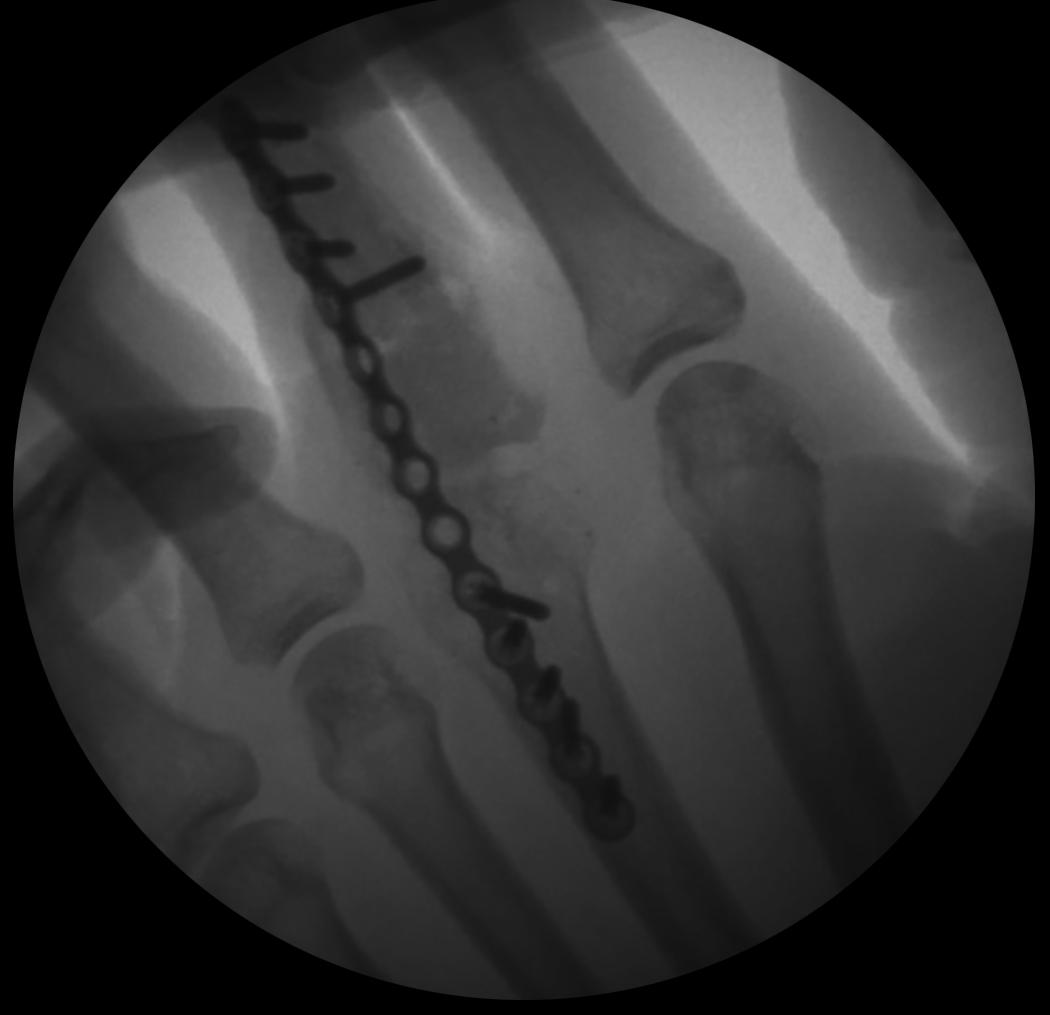
Most metacarpal shaft fractures can be managed nonoperatively. All patients are asked to make a fist and digital alignment and range of motion is assessed at the time of presentation. It is surprising how often x-rays suggest a need for surgery, but the patient exhibits excellent range of motion without digital overlap. Even some cases of multiple metacarpal fractures with rather significant displacement and shortening can do very well without surgery ( Fig. 7.18 ). Fractures that are stable and do not require reduction can be treated in a clam-digger cast or thermoplastic splint until the fracture is clinically nontender. The fractured finger is buddy taped to an adjacent finger and immediate finger flexion is initiated.
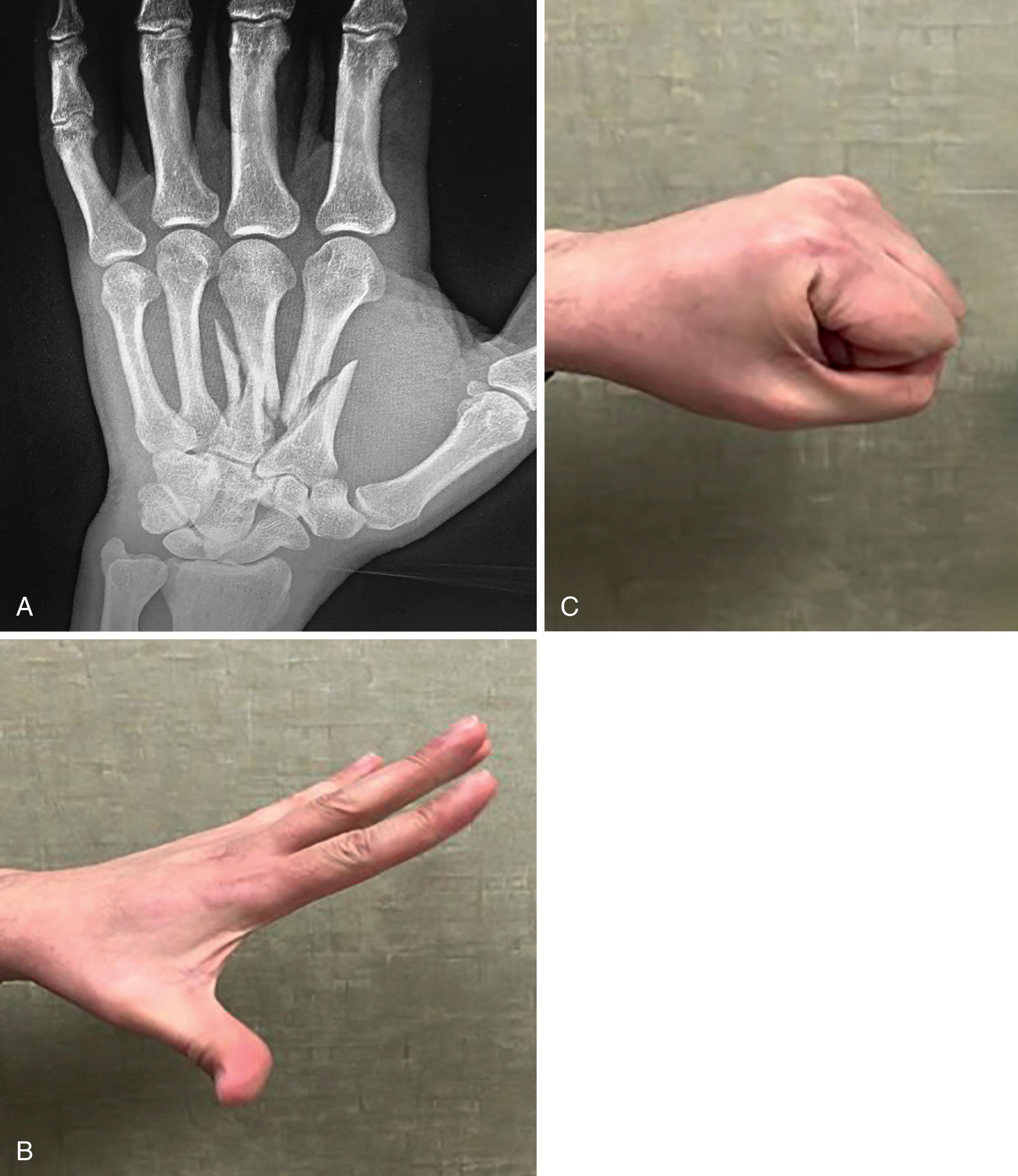
Transverse shaft fractures are usually easy to reduce, but maintenance of acceptable alignment may be difficult. To achieve reduction, a palmarly directed load is applied to the dorsal apex at the fracture site with a counteractive upward (dorsally directed) force on the flexed MCP joint (Jahss maneuver, see Fig. 7.3 ). A well-padded and well-molded forearm-based cast extending to the IP joints and holding the MCP joints in 60 degrees of flexion is then applied. Special attention must be paid to be sure that the nails are in the same plane and that the flexed fingers converge toward the scaphoid tuberosity. The fracture is monitored radiographically at weekly intervals and guarded active range of motion can be initiated at 3 to 4 weeks. Marked swelling, which is often present in acute metacarpal shaft fractures, does not preclude manipulation and casting. Abundant cotton padding must be used and the cast must be changed at 5 to 7 days when the swelling subsides.
For cases in which acceptable alignment cannot be achieved by closed reduction or if the patient’s vocational demands preclude immobilization, surgery is indicated. Fracture configuration, the presence of open wounds, and cost may all impact decision making and surgical technique. IM screw fixation through a percutaneous or limited open approach has become my preferred technique for the overwhelming majority of operative fractures of the midshaft and distal third of the metacarpal (see Fig. 7.5 ). Transverse fractures are ideal; however, the technique can also be effective for oblique and even some comminuted fractures. Anatomic alignment is not required to achieve excellent clinical results, but restoration of length, alignment, and especially rotation is critical. Fractures of the proximal third of the metacarpal shaft can at times also be managed with this technique. IM fixation using antegrade precut Steinmann pin or several Kirschner wires is also particularly well suited for transverse shaft fractures, especially for multiple adjacent metacarpal fractures (see Fig. 7.4 ). In this situation, there is frequently injury to the intrinsic muscles that allows the fracture to be easily distracted, thereby facilitating pin insertion. If the adjacent metacarpal is not fractured, a transverse wire can be added to control rotation. Largely, this technique has been supplanted by retrograde IM screw fixation in my practice, though if cost or implant availability is a concern, IM Kirschner wires remain an excellent technique. For long oblique fractures, I prefer open reduction and lag screw fixation with or without a neutralization plate. Anatomic reduction must first be obtained with a reduction clamp and then typically three lag screws are placed using the above-mentioned technique (see Figs. 7.13 and 7.14 ). The fracture length should be at least twice, and preferably three times, the diameter of the bone at the level of the fracture. Interfragmentary screw fixation is stable enough to allow early active range of motion, but it has the disadvantage of requiring special equipment and being somewhat technically demanding. Reduction is achieved by anatomically interdigitating the proximal and distal apex of the fracture into its corresponding fragment under direct visualization. After this is done, the reduction is held with two bone clamps and the screws are inserted. Fixation may be achieved by using two 2.7-mm screws or three 2.0- or 2.4-mm screws. The diameter of the bone and configuration of the fracture may dictate mixing screws of different diameters in the same fracture.
For complex open fractures, significant comminution, proximal metaphyseal-diaphyseal junction fractures, and fractures with articular extension, I prefer open reduction and fixed angle plate fixation ( Fig. 7.19 ). When open reduction is required, fracture exposure is accomplished through a longitudinal incision just to one side of the extensor tendon overlying the involved metacarpal. If all four metacarpals require reduction, two longitudinal incisions are best, one between the fourth and fifth metacarpals and the other between the second and third metacarpals. Care is taken to preserve the small dorsal sensory branches of the radial and ulnar nerves and the peritenon surrounding the extensor tendons. Occasionally, one of the juncturae tendinum requires division for better fracture visualization; should this be necessary, the junctura should be repaired following fixation. The fracture ends are exposed subperiosteally and cleaned of blood clots with a small curette. Reduction is then accomplished by applying longitudinal traction and is maintained with reduction clamps. Creativity with newer plate designs allows clusters of locking screws to be used to capture virtually any fracture pattern and allow early motion secondary to secure internal fixation. In general, I reserve plate and screw fixation for complex situations such as open fractures when there is a combination of diaphyseal bony loss or comminution associated with significant soft tissue injury (see Figures 7.14, 7.15, and 7.18 ). Successful plate application is technically gratifying, provides stable fixation, and maintains length when there has been comminution or bone loss. However, plate application is demanding and there is no margin for error. Application requires considerable soft tissue mobilization, and despite design improvements the plates remain a source of potential irritation to the overlying extensor tendons. Sometimes removal is necessary and a fracture can occur through a screw hole or at the “original” fracture site. I prefer a 2.4-mm plate, which allows screw fixation of at least four cortices, both proximal and distal to the fracture, to ensure stable fixation. Supplemental fixation with an interfragmentary screw (for transverse and short oblique fractures) placed either through a hole in the plate or obliquely across the fracture significantly enhances fracture stability. Plate fixation is undesirable if the fracture cannot be covered by local soft tissue or flaps. In such situations, I prefer external fixation or IM screw fixation. I do not routinely remove plates. If the plate is perceived as bulky or is irritating, I will remove it. Also, if there are restrictive adhesions and a tenolysis/capsulotomy is indicated, I remove the plate. One should tell the patient that refracture may occur following plate removal.
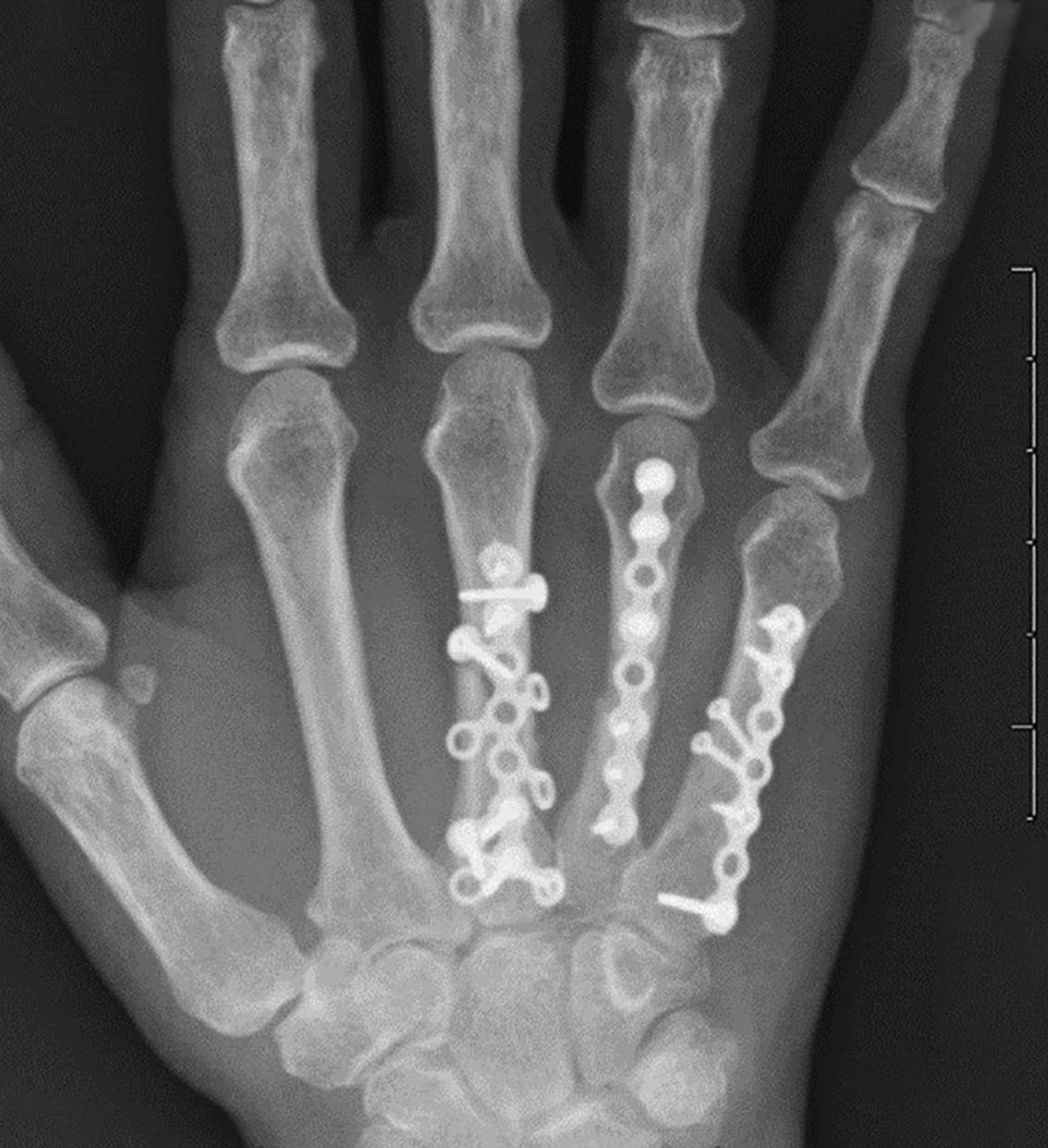
In cost-conscious patients with relatively simple fracture patterns that fail nonoperative treatment, I prefer to use percutaneous pin fixation in the office using WALANT. The technique of WALANT is the same as presented above for metacarpal neck fractures. Most often I utilize retrograde pins started in the nonarticular portion of the metacarpal head and advanced down the canal and into the CMC joint or subchondral bone of the metacarpal base ( Fig. 7.20 ). Patients are immobilized in an ulnar gutter splint and typically begin range-of-motion exercises at 1 week and have the pins removed at 4 weeks.
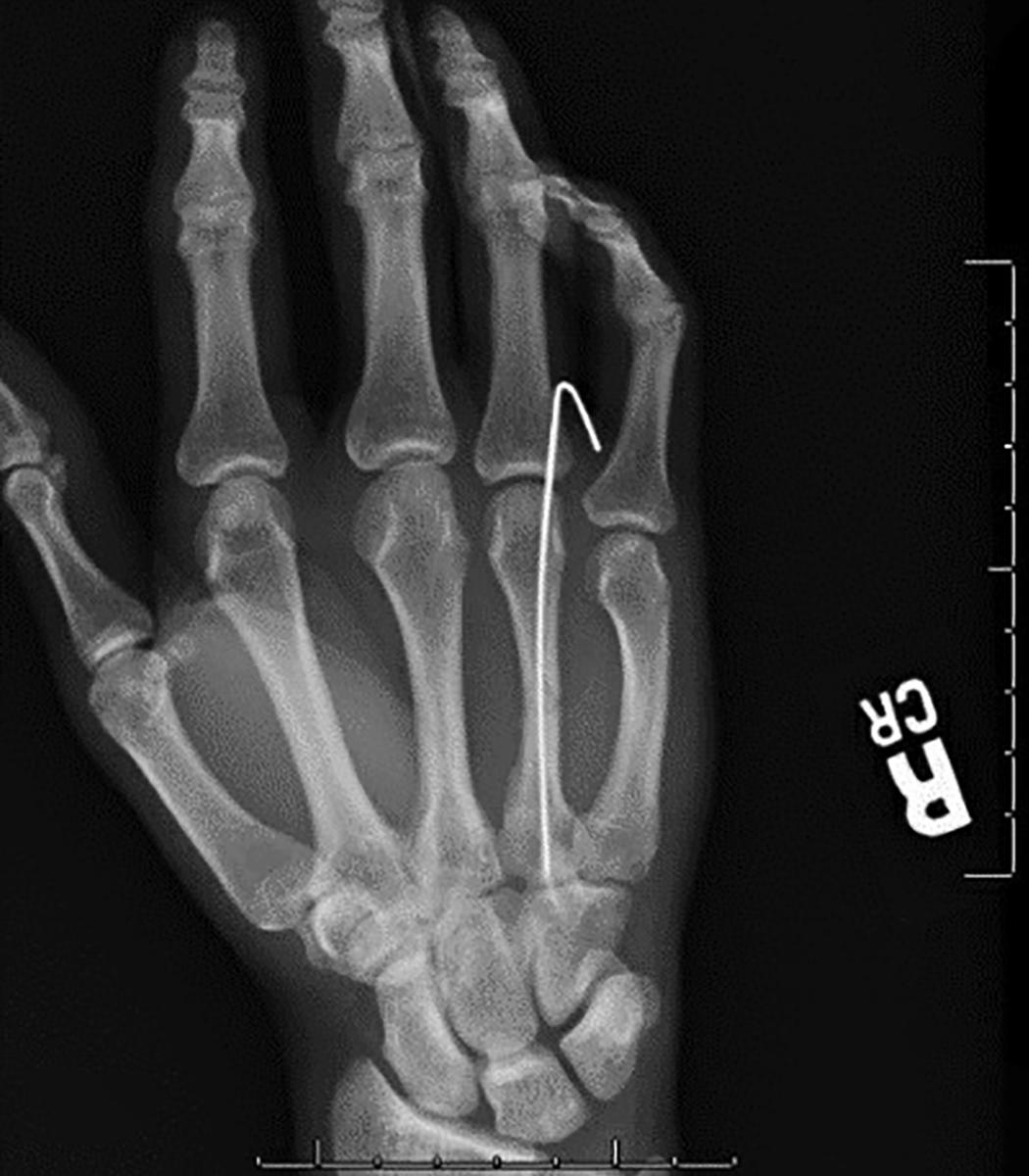
Although infrequently used in the United States, bioabsorbable implants are commonly used in some European locations. During fracture healing, the implants maintain fracture stabilization; however, over time they hydrolyze, resulting in stresses being transferred to the healing bone and thereby avoiding stress shielding. The implants are composed of either trimethylene carbonate, polyglycolic acid (PGA), polylactic acid (PLA), or polyparadioxanone and can be fabricated into pins, screws, rods, or plates. Biomechanical testing in cadaveric metacarpal and phalangeal bone shows that the implants provide fixation stability that is not statistical different from to metal implants. Because they resorb, a second procedure to remove the implant is avoided. The most common complication is a noninfectious inflammatory response that occurs 7 to 30 weeks following fracture fixation in approximately 5% to 25% of the cases.
Clinically, bioabsorbable IM rods were compared with metal implants for the fixation of metacarpal and phalangeal shaft fractures. There were no differences in outcome with respect to time to union, range of motion, and return to work. In a 1996 study, biodegradable pins (12 patients) were compared with Kirschner wires (11 patients) in the fixation of fractures, arthrodesis, and osteotomies in a prospective randomized study. No difference in time to union or complications was observed. Moreover, there were no inflammatory reactions in the biodegradable cohort. Given the lack of well-controlled recent studies or clear advantages, there is insufficient evidence to support the routine use of absorbable implants for metacarpal fracture fixation.
Restoration of metacarpal stability and function following segmental bone loss is a challenge. This situation occurs following an open injury and is nearly always associated with varying degrees of soft tissue injury or loss. Restoration of hand function is usually staged and begins with a thorough debridement of devitalized tissue. The timing of the soft tissue reconstruction is beyond the scope of this chapter, but it should not begin until a stable osseous framework has been achieved.
There are two classic philosophies regarding the primary management of acute metacarpal segmental bone loss. The traditional viewpoint espoused by Peimer et al. advocates maintaining metacarpal length with transverse intermetacarpal Kirschner wires and/or external fixation devices, with soft tissue coverage performed as a primary or delayed primary procedure. Bone grafting is performed only after joint motion is regained and healed wounds have matured. They reported nine patients with an average of 2 years elapsed by the time secondary reconstructions by bone, nerve, and tendon grafts or transfers were completed.
Freeland et al. believes that the best time to restore osseous stability with a bone graft and internal fixation is within the first 10 days of injury (“the golden period of wound repair”). They achieved union without infection in 20 of 21 delayed primary bone grafts after traumatic bone loss in the hand and wrist (11 involved the metacarpals). Initial wound care consisted of debridement and temporary skeletal stabilization. The wound was reinspected 3 to 7 days later, and if judged to be ready for closure or coverage, definitive fracture stabilization, bone grafting, and skin flap coverage (if required) were performed. Calkins et al. reported satisfactory functional results in 9 of 10 patients who had traumatic segmental bone defects of the hand. Corticocancellous grafts were inserted within 2.5 weeks of injury. The soft tissue wounds were left open, there were no cases of infection, and all grafts went on to incorporate. The authors believed that stable fixation combined with bone grafting promoted optimum return of function by allowing for early mobilization to minimize chronic swelling, pain, tendon adhesions, and articular stiffness. Stahl et al. recommended immediate bone grafting combined with internal fixation and soft tissue coverage when there was segmental bone loss.
Along similar lines, Gonzalez et al. reported excellent results in the treatment of 64 metacarpal fractures secondary to low-velocity gunshot wounds treated with early (between 1 and 7 days) stabilization, usually with an IM rod and supplemental iliac crest bone graft. There were no deep infections. The average range of motion at the MCP joint was 65 degrees, and the average shortening was 1.4 mm for high-velocity injuries (72,000 feet/second).
The use of a temporary methylmethacrylate spacer to fill a bony defect and create an induced membrane for subsequent bone grafting has gained popularity. This technique, known as the Masquelet technique, was originally described for tibial nonunions but has been widely adopted for infected and noninfected nonunions throughout the upper and lower extremity, including the hand. This two-staged approach first involves temporary skeletal stabilization (internal or external fixation) augmented with the placement of a polymethyl methacrylate (PMMA) spacer (with or without added antibiotics) for 4 to 6 weeks. A highly angiogenic and osteoinductive pseudomembrane is formed, and a second stage procedure for the removal of the PMMA spacer and addition of cancellous bone graft into the pseudomembrane is carried out (see Fig. 7.2 ).
Alternatively, corticocancellous bone grafts can be utilized to fill defects. Most defects can be bridged with corticocancellous grafts harvested from the iliac crest. If more than one metacarpal has segmental loss, a large tricortical iliac crest bone graft designed to fit the defects in all metacarpals may be required ( Fig. 7.21 ).
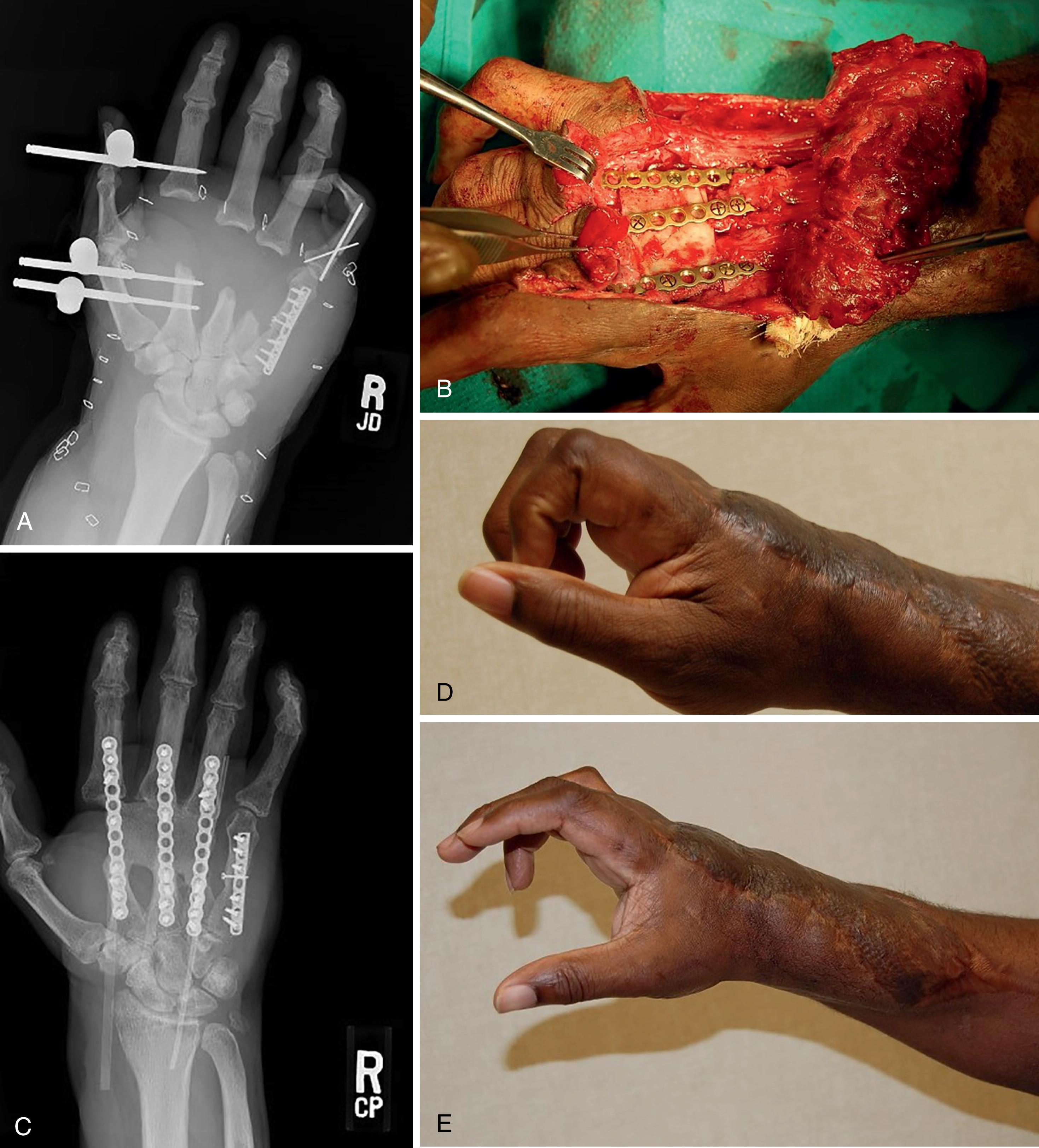
For more challenging cases of soft tissue and bone loss, combined free tissue transfer to restore osseous needs and coverage, as either a single flap or a chimeric flap, have been described. Rose used a delayed primary vascularized free groin flap to cover a large central hand defect in a 12-year-old boy. Subsequently he reconstructed the bone loss with a free vascularized second MCP joint and common extensor tendons of the second and third toes.
Generally, when there is metacarpal bone loss, there has been some injury or loss of the dorsal skin and extensor tendons. Following thorough debridement, temporary stability is achieved with an external fixator or IM pins. The patient is then returned to the operating room for additional debridement over the next 3 to 5 days, until the wound is surgically clean. At that time, either a PMMA spacer is used in a Masquelet fashion or a corticocancellous or cancellous bone graft is harvested from the iliac crest or proximal ulna and fashioned to fit into the defect, with stabilization accomplished with an appropriately contoured dorsal plate. When there is bone loss from multiple metacarpals, I prefer to use a single block of graft, rather than individual metacarpal bone reconstruction. Soft-tissue coverage is obtained with either a regional, distant, or free flap. I prefer staged tendon reconstruction in which silicone rods are inserted at the time of flap coverage and replaced later with free tendon grafts; however, some patients tolerate an absent extrinsic extensor mechanism following these injuries and do not require extensor tendon reconstruction.
Isolated articular fractures of the base of the second and third metacarpals are rare because of the lack of motion in these joints: hence, there is no consensus regarding optimal treatment. These are usually the result of a fall on a palmar flexed wrist. Patients typically present with a palpable bony fragment and pain or weakness with resisted wrist extension. Avulsion fractures from the dorsal base of the index and/or middle metacarpals have been successfully managed both operatively , and nonoperatively. Justification for surgical reattachment includes restoration of the integrity of the extensor carpi radialis longus or brevis as a functional wrist extensor, prevention of EPL tendon rupture, reconstitution of the articular surface of the carpometacarpal joint, and elimination of a potentially irritating fragment of dorsal bone, which can often tent the overlying skin.
Articular fractures of the hamate-metacarpal joint are common and typically the result of either a direct blow with a closed fist or high-energy trauma. These injuries are usually associated with proximal and dorsal subluxation of the metacarpal, though palmar dislocations are also reported. , Kerr was the first to point out the similarities between this injury and Bennett fracture, and this fracture has subsequently been referred to as a “baby Bennett fracture.” The hamate articulates with the ring and small metacarpals by two concave facets separated by a ridge. The base of the fifth metacarpal consists of a concave-convex facet that articulates with the hamate and a flat radial facet that articulates with the fourth metacarpal base. Dorsal and palmar intermetacarpal ligaments and an interosseous ligament stabilize the intermetacarpal joint. The injury results from a longitudinally directed force along the long axis of the fifth metacarpal. Usually a radial portion of the fifth metacarpal base remains articulated with the hamate and fourth CMC base, whereas the rest of the metacarpal is subluxated proximally and dorsally. The displacement is accentuated by the pull of the extensor carpi ulnaris. Lilling and Weinberg noted that the pull of the abductor digiti minimi as well as the oblique slope of the hamate also contributed to the instability of CMC fracture-dislocations of the small finger.
Because the extent of the injury is frequently missed on routine x-rays, Bora and Didizian have recommended an anteroposterior (AP) view with the forearm pronated 30 degrees from the fully supinated position. The diagnosis can also be made by CT or a Brewerton view. Kim et al. recently reported three-dimensional CT reformatted views to have a higher interobserver and intraobserver reliability than standard two-dimensional CT.
There is no consensus regarding optimal treatment of these fractures as evidenced by a recent systematic review. Options run the gamut from closed reduction and cast immobilization to spanning external fixation or open reduction and internal fixation. Successful closed reduction and cast immobilization have been reported by Lundeen and Shin and Hsu and Curtis. However, Bora and Didizian found that weakness of grip was the major functional disability resulting from inadequate reduction. Reduction of these fractures may be unstable, and I agree with several authors that have advocated simple closed reduction and percutaneous pin fixation of the fifth metacarpal to the fourth metacarpal or carpus to maintain reduction. ,
Alternatively, open reduction and buttress plate application has been demonstrated in a case series of 11 patients to successfully reduce the fracture while maintaining the mobility of the ulnar-sided CMC joints by not securing the distal end of the plate to the metacarpal. Five patients (45%) required a second surgery for hardware removal.
Petrie and Lamb treated 14 fracture-dislocations of the fifth metacarpal-hamate joint by immediate, unrestricted motion and reviewed them at 4.5 years. Despite persistent metacarpal shortening, incongruity in the articular surface, and widening of the joint, only 1 patient had pain significant enough to affect work. They believed that the case for surgical treatment was not strong, inasmuch as arthrodesis of the joint could always be performed for persistent pain. On the other hand, Kjaer-Petersen et al. reported that regardless of the method of treatment (closed, percutaneous, or open), 19 of 50 (38%) patients had some symptoms at a median follow-up of 4.3 years. They believed that restoration of the articular surface should be the goal of treatment. Papaloizos et al. also advocated open reduction and noted that pain directly correlated with degenerative arthritis, which was attributed to nonanatomic reduction in several of their cases.
Cain et al. noted that fracture-dislocations of the fourth and fifth metacarpal joints, in association with comminuted dorsal hamate fractures or coronal fractures through the hamate, were particularly unstable and thus open reduction was uniformly necessary. When the hamate shear fracture is a single fragment, screw fixation of the hamate fragment to the body serves to treat both the fracture and the dislocation. ,
Multiple CMC dislocations are high-energy injuries that nearly always require open reduction. , While the majority of these high-energy injuries are dorsally displaced, palmar dislocations and divergent dislocations are also well described. A high index of suspicion for associated carpal fractures, intercarpal ligament injuries, neurovascular injuries, and compartment syndrome should be suspected given the high-energy nature of these injuries. Lawlis and Gunther reported on 20 patients, 14 of whom had multiple CMC dislocations. Closed reduction was generally associated with recurrent dislocation or subluxation, and open reduction with Kirschner wire fixation was recommended for these injuries. At 6.5-year follow-up, 3 of the 4 patients with unsatisfactory results had closed treatment, and the fourth had a concomitant ulnar nerve palsy.
Schortinghuis and Klasen reported on open reduction of combined fourth and fifth CMC dislocations in 11 patients. They noted that placing a screw or plate across the fourth CMC led to spontaneous reduction of the fifth metacarpal. This permitted early range of motion and satisfactory results in all cases, though all had revision surgery for hardware removal.
Clendenin and Smith reported successful relief of symptomatic arthritis of the hamate-fifth metacarpal joint in seven patients treated by arthrodesis using an iliac crest bone graft. An alternative technique for painful fifth CMC arthritis is termed the “stabilized arthroplasty” and involves resection of the fifth metacarpal base and side-to-side fusion between the fourth and fifth metacarpal bases. Six of eight patients were evaluated at an average of 93 months following this procedure and demonstrated to have 10 to 20 degrees of fourth CMC mobility, excellent reduction of pain, but up to 70% loss of grip strength. Resection arthroplasty, , suspension arthroplasty using a slip of extensor carpi ulnaris (similar to thumb CMC arthroplasty), and silicone interposition arthroplasty have also been used for posttraumatic hamate-metacarpal arthritis.
Fracture-dislocations of the fifth CMC joint are inherently unstable, and closed reduction and cast immobilization can be risky. Redislocation may not be appreciated because x-ray imaging is difficult as a result of bony overlap and plaster artifact. Also, many of these injuries occur in unreliable patients. Therefore for simple fracture-dislocations of the fifth CMC joint, I prefer closed reduction and percutaneous pinning. After adequate regional or general anesthesia, longitudinal traction is applied and downward pressure exerted on the base of the fifth metacarpal. Under image intensification, a first pin can be obliquely directed across the fifth metacarpal-hamate joint and a second pin either divergently placed across the fifth CMC joint or transversely from the fifth metacarpal base into the fourth metacarpal base ( Fig. 7.22 ). When multiple fragments or comminution exists, preoperative CT or tomography is useful. If open reduction is elected, a dorsoulnar incision is used to visualize the joint. Care must be taken to protect the dorsal sensory branch of the ulnar nerve. The joint is debrided of fracture fragments, the articular surface is reduced as best as possible, and reduction is maintained with multiple Kirschner wires or small screws. Postoperatively, a forearm-based ulnar gutter splint with the IP joints left free is applied. I typically cast these patients at the follow-up visit for an additional month and then the pins are removed at 6 weeks at which time wrist and MCP motion are initiated.
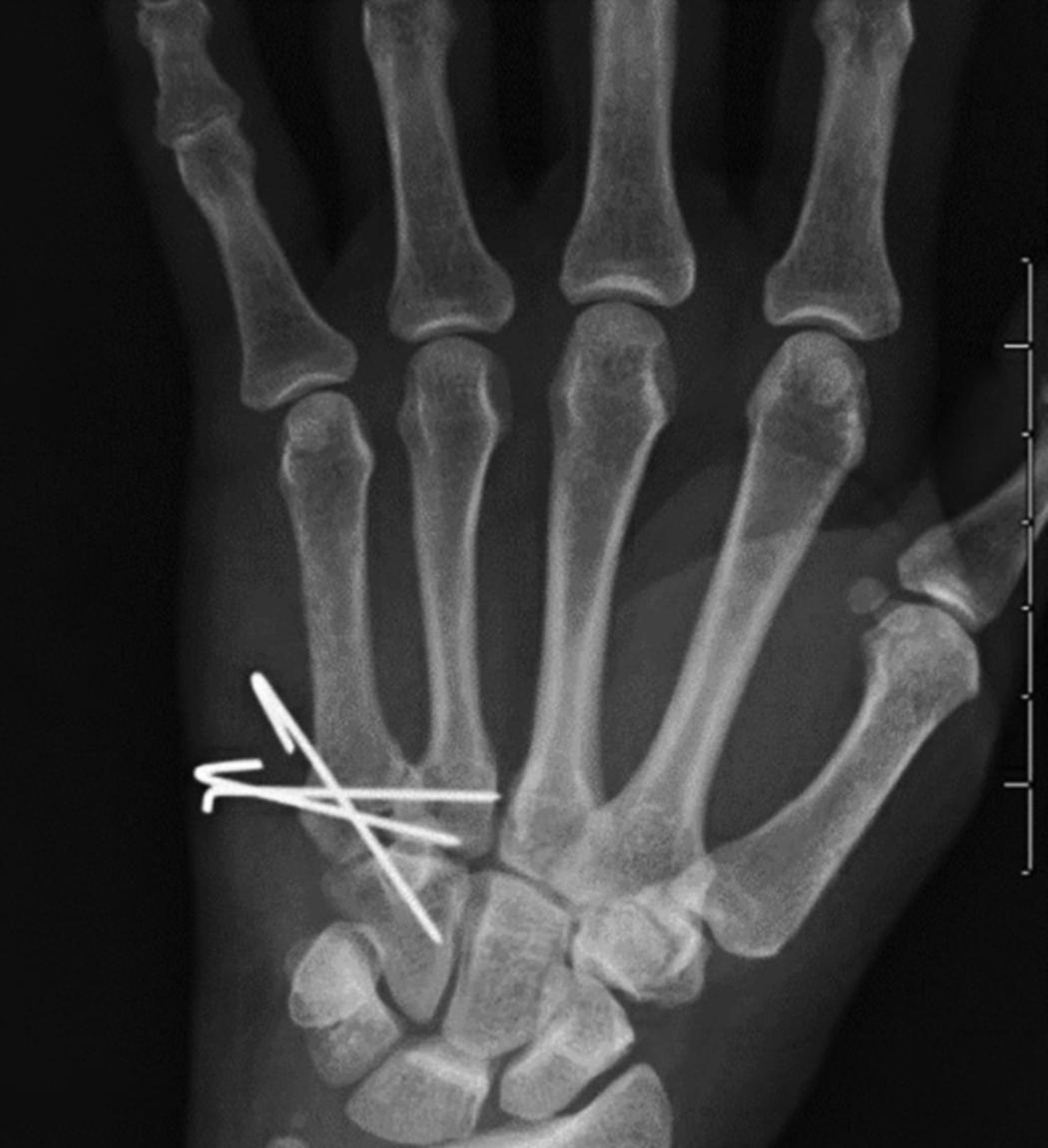
For multiple CMC joint dislocations, open reduction is nearly always indicated. My preference is one incision between the index and long metacarpals and a second incision between the fourth and fifth metacarpals. Superficial branches of the radial sensory nerve and dorsal cutaneous branch of the ulnar nerve should be identified and protected. The reduction is usually simple to accomplish and can be maintained with Kirschner wires extending from the metacarpals into the carpal bones. I then immobilize patients for 6 weeks in a short-arm cast including the MCP joints (IP free). Pin removal is around 6 weeks along with initiation of range-of-motion exercises.
If a fracture-dislocation of the fifth CMC joint is seen more than 3 weeks after the injury, I prefer to accept the alignment. If symptomatic arthritis exists a year or more after the injury, a salvage procedure can be carried out.
For patients with symptomatic CMC joint arthritis, I prefer the Dubert procedure, which involves resection the arthritic joint and a side-to-side fusion of the fifth metacarpal base to that of the fourth metacarpal base with autograft. Fixation can be achieved with screws, plate, or staples ( Fig. 7.23 ). For symptomatic second or third CMC arthritis, my preference is direct fusion of the CMC joint given the limited range of motion at these joints using compression staples and distal radius autograft.
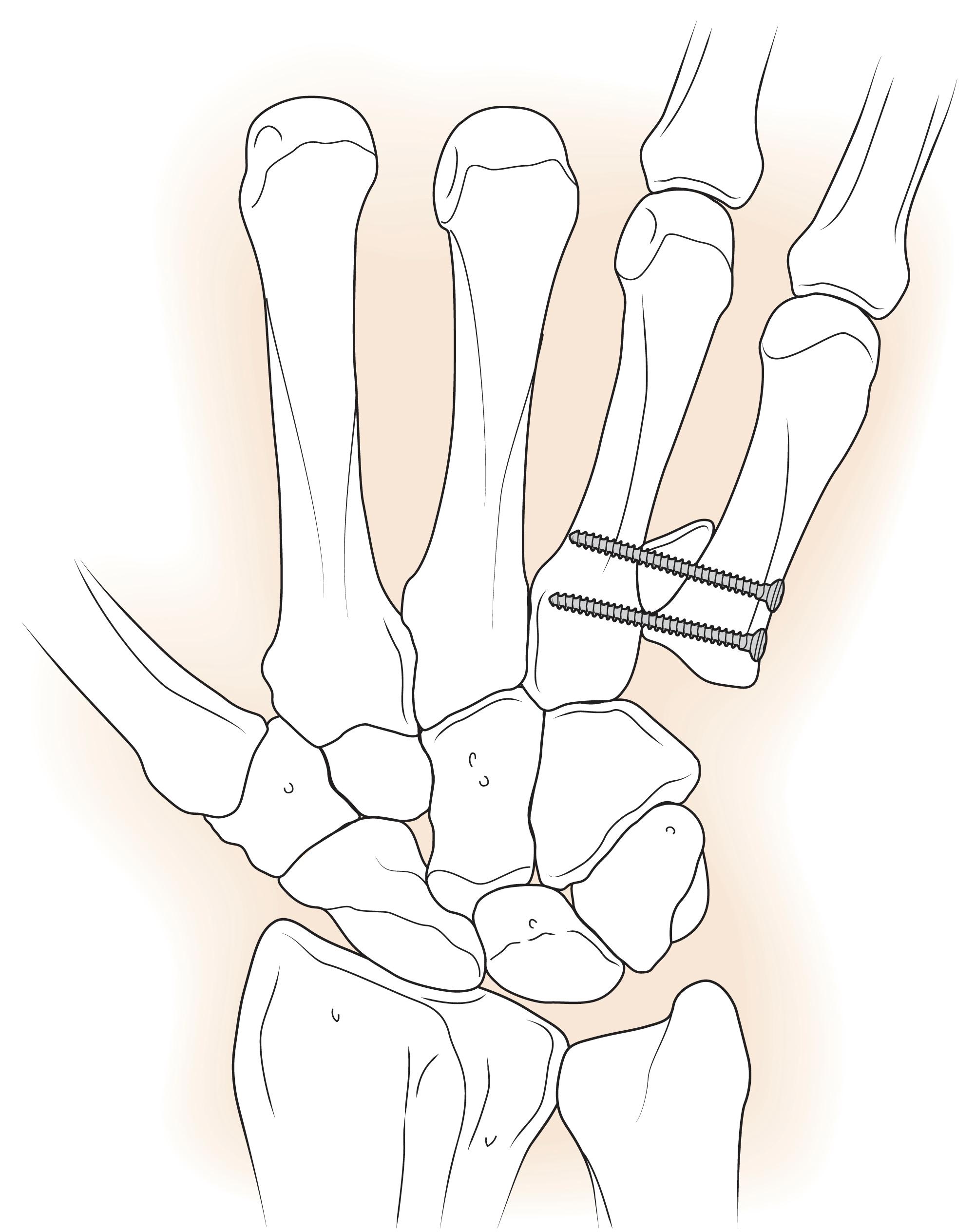
Metacarpal malunions may be classified as either articular or nonarticular. Nonarticular malunions may be angulatory, usually as a result of a malunited transverse shaft fracture; rotational, as a result of a spiral or oblique fracture; or shortened, as a result of a crush injury with bone loss. Following crushing injuries or open fractures, there may be shortening and associated soft tissue problems such as tendon adhesions, poor skin coverage, and neurologic deficit. In such cases, it may be most expeditious to perform an osteotomy and correct the soft tissue problem(s) simultaneously.
With modern techniques of plate and screw fixation or IM screws, union rates of metacarpal osteotomy have approached 100% and there has been a high degree of clinical satisfaction. , Lucas and Pfeiffer reviewed the AO experiences with osteotomies for 26 metacarpal and 10 phalangeal malunions. The osteotomy was done at the site of the deformity and fixation was accomplished with dorsal plates and screws. There were no nonunions, and 86% of the patients were satisfied. The failures were due to loss of motion or failure to fully correct the deformity. For more complex malunions, preliminary studies have shown patient-specific three-dimensional custom guides to be useful for precise correction.
Metacarpal malunion following a transverse fracture results in dorsal angulation in the sagittal plane. Despite impressive radiographic malalignment, many nonarticular metacarpal malunions, especially those involving the ulnar digits, may be well tolerated and produce little functional deficits. Westbrook et al. found no correlation between the degree of dorsal angulation and patient reported outcomes in a series of 113 fractures; conversely, the authors found significantly better DASH scores in nonsurgically treated fifth metacarpal shaft fractures. At times, however, these malunions may cause weakness of grip or pain. Healing of second and third metacarpals with angulation is more likely to be bothersome, both cosmetically (pseudoclawing) and functionally (prominent metacarpal head in the palm that is painful when gripping). Correction can be accomplished through either an opening or closing wedge osteotomy. A closing wedge osteotomy is simpler, but critics have cited the disadvantage of further metacarpal shortening. However, Wolfe and Elliot demonstrated that the amount of dorsal bone removed for a 60-degree closing wedge osteotomy is more than compensated by restoration effected by the angular correction, resulting in a 7% gain in length ( Fig. 7.24 ). Preoperatively, the size of the wedge is calculated by using a template, and intraoperatively the volar periosteum is left intact to act as a hinge. I prefer fixation with a 2.4-mm dorsal plate or IM screw depending on the canal diameter. Supplemental cancellous bone graft harvested from the distal end of the radius is packed around the osteotomy. Union usually takes longer than after uncomplicated fracture fixation.
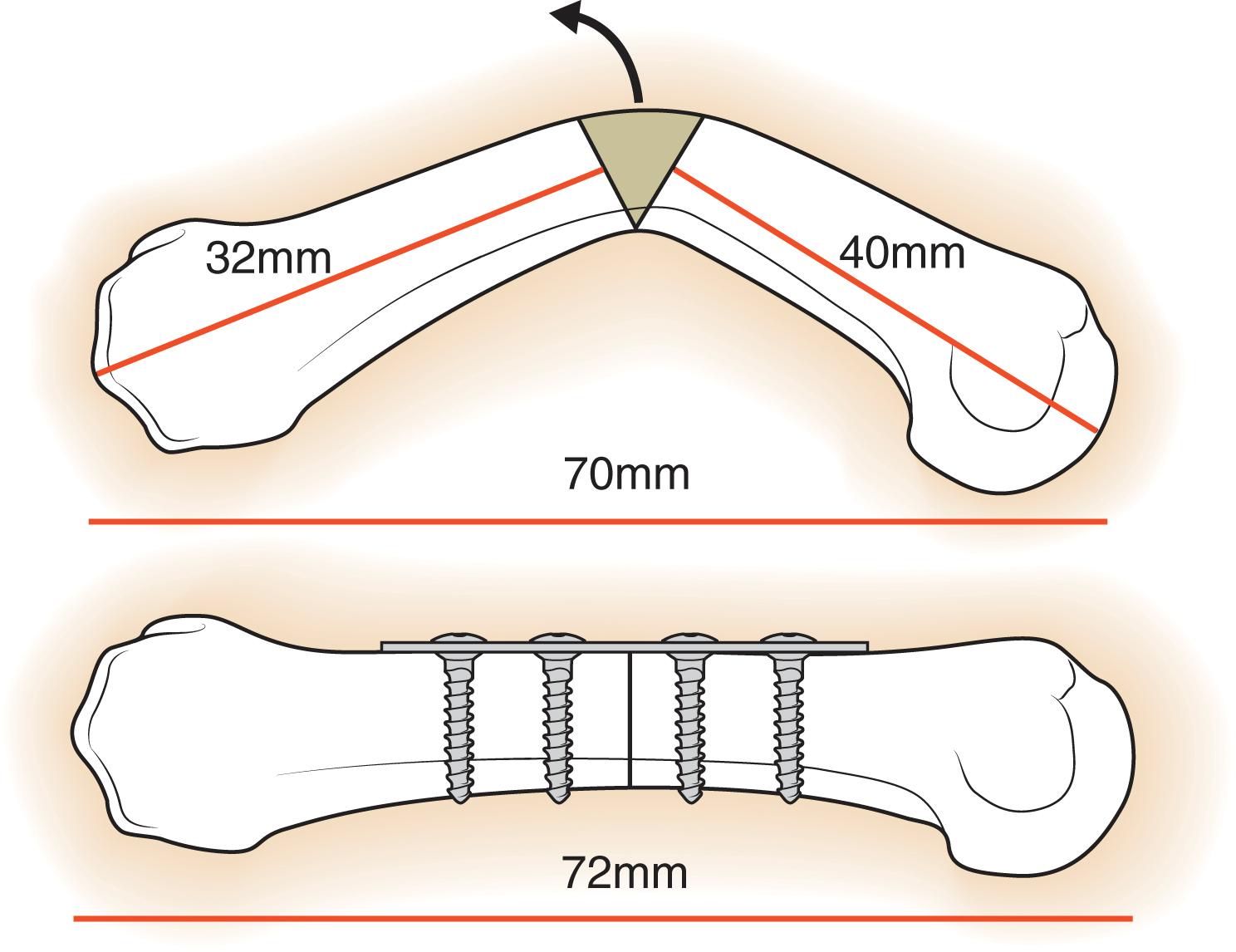
If the metacarpal is appreciably shortened due to bone loss, an opening wedge volar osteotomy can be performed through a dorsal approach with the expectation of several millimeters of lengthening ( Fig. 7.25 ). Cancellous bone graft should be placed in the volar defect. Stable fixation to allow early motion is accomplished with a dorsal plate. For cases with segmental metacarpal bone loss, a trapezoidal intercalary-type graft can be performed, but this is technically more difficult and may require considerable distraction.
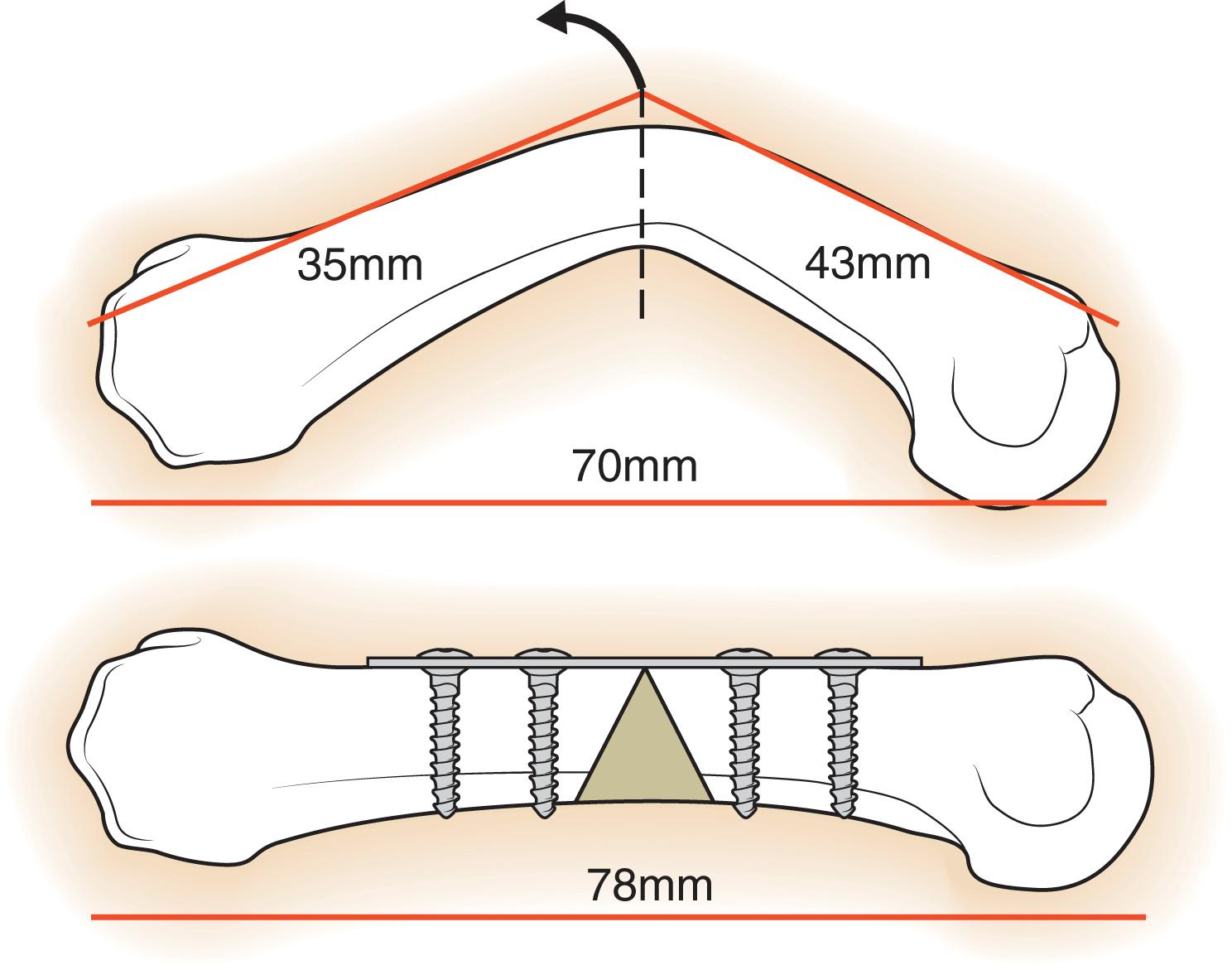
Rotational malunion of a metacarpal can result in overlapping of the affected finger over an adjacent finger (scissoring). It usually results from a malunited spiral or oblique fracture. The cosmetic deformity is often marked and grip is impaired. Weckesser advocated a corrective osteotomy through the base and was able to correct up to 25 degrees in each direction for either metacarpal or phalangeal malunions. Fixation was accomplished with two transverse Kirschner pins through the distal fragment and into the adjacent metacarpal and was supplemented with a longitudinal pin extending across the osteotomy site ( Fig. 7.26 ). Menon reported full rotational correction of 11 of 12 osteotomies through the metacarpal base. Before the osteotomy, he inserted a Kirschner wire into the metacarpal perpendicular and distal to the osteotomy site, performed a transverse osteotomy, and then used the Kirschner wire as a handle to rotate the distal fragment into the desired position. Fixation was accomplished with crossed Kirschner wires. Manktelow and Mahoney used a rotational step-cut osteotomy to successfully correct metacarpal malrotation in 10 patients. Two transverse hemiosteotomies on opposite sides of the metacarpal diaphysis are cut and connected by a longitudinal dorsal osteotomy. A predetermined longitudinal strip of dorsal cortex is removed (1.3 mm of dorsal bone results in 1 cm of fingertip correction), and then a longitudinal fracture is created in the volar diaphyseal surface by compressing with a bone clamp. Tightening with interosseous wires approximates the gap. Pichora et al. and Jawa et al. advocated interfragmentary screw fixation of the diaphyseal split rather than interosseous wires (see Fig. 7.26 ).
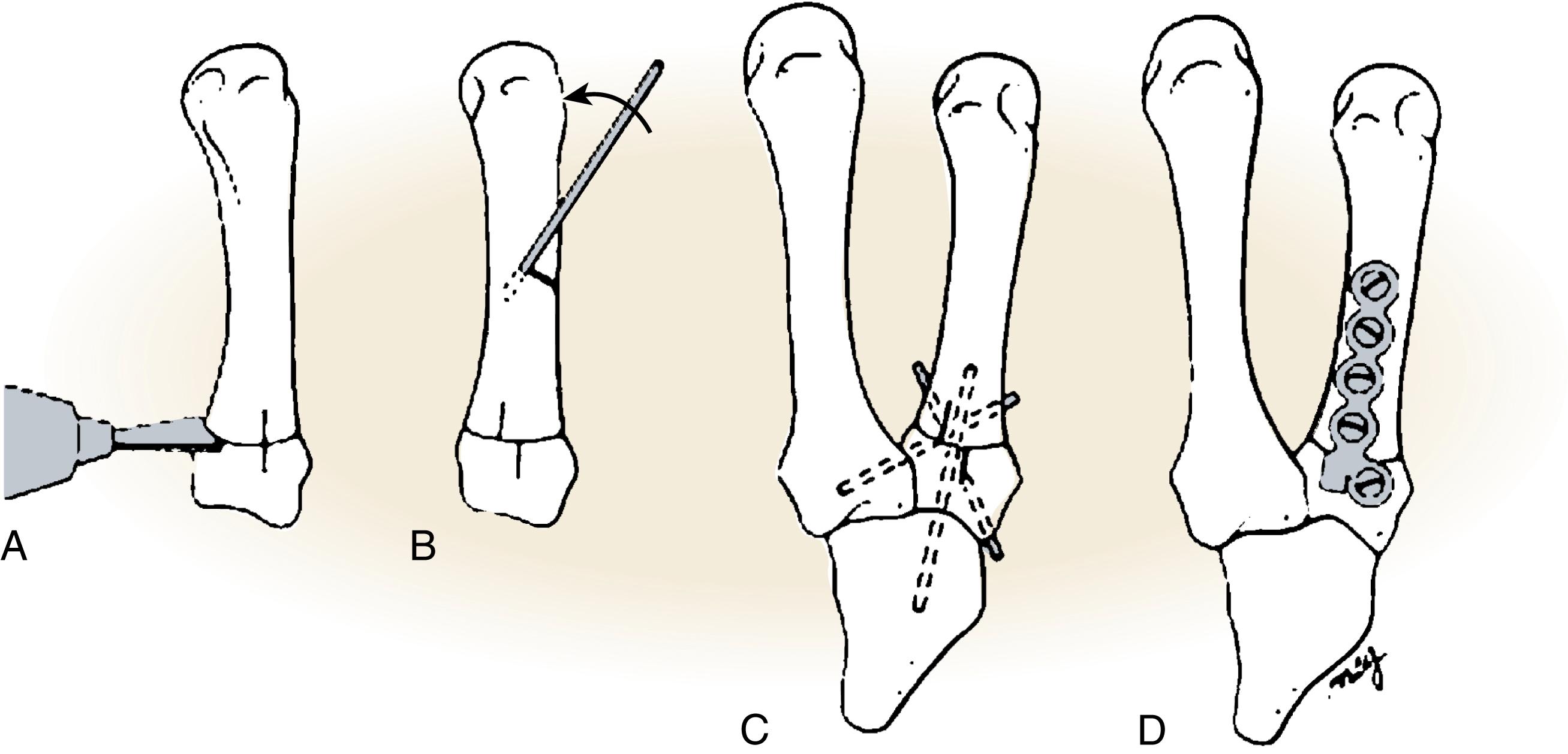
I have been pleased with the results achieved when the osteotomy is performed through the metaphyseal base. After rotational correction, the osteotomy is transfixed with a longitudinal Kirschner pin. Correction is then assessed by observing the tenodesis effect of wrist flexion and extension, assessment of the plane of the fingernails, and checking that the fingertips point to the scaphoid tuberosity. If satisfied with the correction, I prefer fixation with a T-plate, L-plate, or minicondylar plate. Some small locking plate fixation systems allow for in situ bending to be performed after provisional fixation. This in situ bending allows additional precision for rotational alignment.
Articular malunions are challenging, often symptomatic, and rarely amenable to corrective osteotomy. If the fracture line can be visualized and bone stock is satisfactory, osteotomy with reconstitution of the articular surface is the optimum treatment. , Duncan and Jupiter reported successful correction of three malunited metacarpal head fractures by performing an osteotomy through the malunion and maintaining the reduction with either screws and a plate or screws alone supplemented with cancellous bone graft. When presenting late, these fractures often require salvage procedures such as arthrodesis or arthroplasty.
Osteomyelitis following metacarpal fracture fixation or nonunion is uncommon and treatment must be individualized. In a review of osteomyelitis of the tubular bones of the hand, delay in treatment of more than 6 months or more than three procedures was associated with a very high amputation rate. For metacarpal shaft osteomyelitis, I prefer staged treatment using the Masquelet technique:
Remove loose implants and generously debride bone and soft tissue. Gram stains and multiple cultures are sent for aerobic, anaerobic, and atypical organisms as warranted. Stabilization and length preservation can be provided with an IM pin and supplemented with a block of polymethylmethacrylate (with or without antibiotics added). This creates a biologically favorable induced membrane for insertion of a future bone graft. Appropriate systemic antibiotics are administered for at least 4 to 6 weeks.
Typically around 6 weeks later, stage 2 surgery consists of removal of the antibiotic spacer, preservation of the induced membrane, placement of cancellous autograft, closure of the induced membrane over the graft, and fixation with plates and screws.
Become a Clinical Tree membership for Full access and enjoy Unlimited articles
If you are a member. Log in here